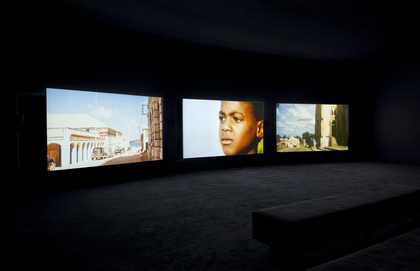
Sir John Akomfrah CBE, The Unfinished Conversation 2012. Tate. © John Akomfrah / Smoking Dogs Films.
Sixty Years: The Unfinished Conversation
Explore the evolving nature of diasporic identity through art from Tate’s collection
Diaspora identities are those which are constantly producing and reproducing themselves anew, through transformation and difference.
Stuart Hall
The term diaspora comes from an ancient Greek word meaning ‘to scatter’. Today it refers to people who have migrated from one part of the world to another, or come from families who have. This is true in one way or another of all of the artists included. The renowned cultural studies theorist Stuart Hall saw identity as being full of endless possibilities. Rooted in this outlook, Sixty Years: The Unfinished Conversation seeks to present a sense of pluralism, that all identities, beliefs and differences are accepted, respected and ongoing. Based around John Akomfrah’s film work about Hall, the display features works which defy predetermined or fixed notions of diasporic identity. This draws upon Hall’s ideas that our cultural identity is a matter of ‘becoming’, rather than simply ‘being’. The central idea in this display is that identities of ethnicity, gender, sexuality and class do not function around a singular axis of ‘difference’ and are instead constantly undergoing transformation. Rather than presenting diasporic cultures and identities as binding or singular, they are presented as complex unfinished conversations.
Collective memory and networks forged within and across diasporic groups are an important part of the connections between the artists featured here. Even where ruling classes and dominant cultures have the power to impose restricted world views, people and communities still find a way to express themselves in a way that is true to their own individual understanding of the world.
There is no singular order or chronology to the display. You are invited to make your own connections to and between the works: to look closely at what is distinctive in the subjects, as well as in the artworks themselves. Threads of thought connecting the artworks suggest themes such as migration, marginalisation, memory, kinship, celebration, healing and resilience. We hope you will discover meanings in many different ways, unsettling fixed narratives of nationhood and belonging and recognising that selfhood and identity can only come into existence through our relationships to others. Hall suggested that ‘The future belongs to the impure. The future belongs to those who are ready to take in a bit of the other, as well as being what they themselves are.’
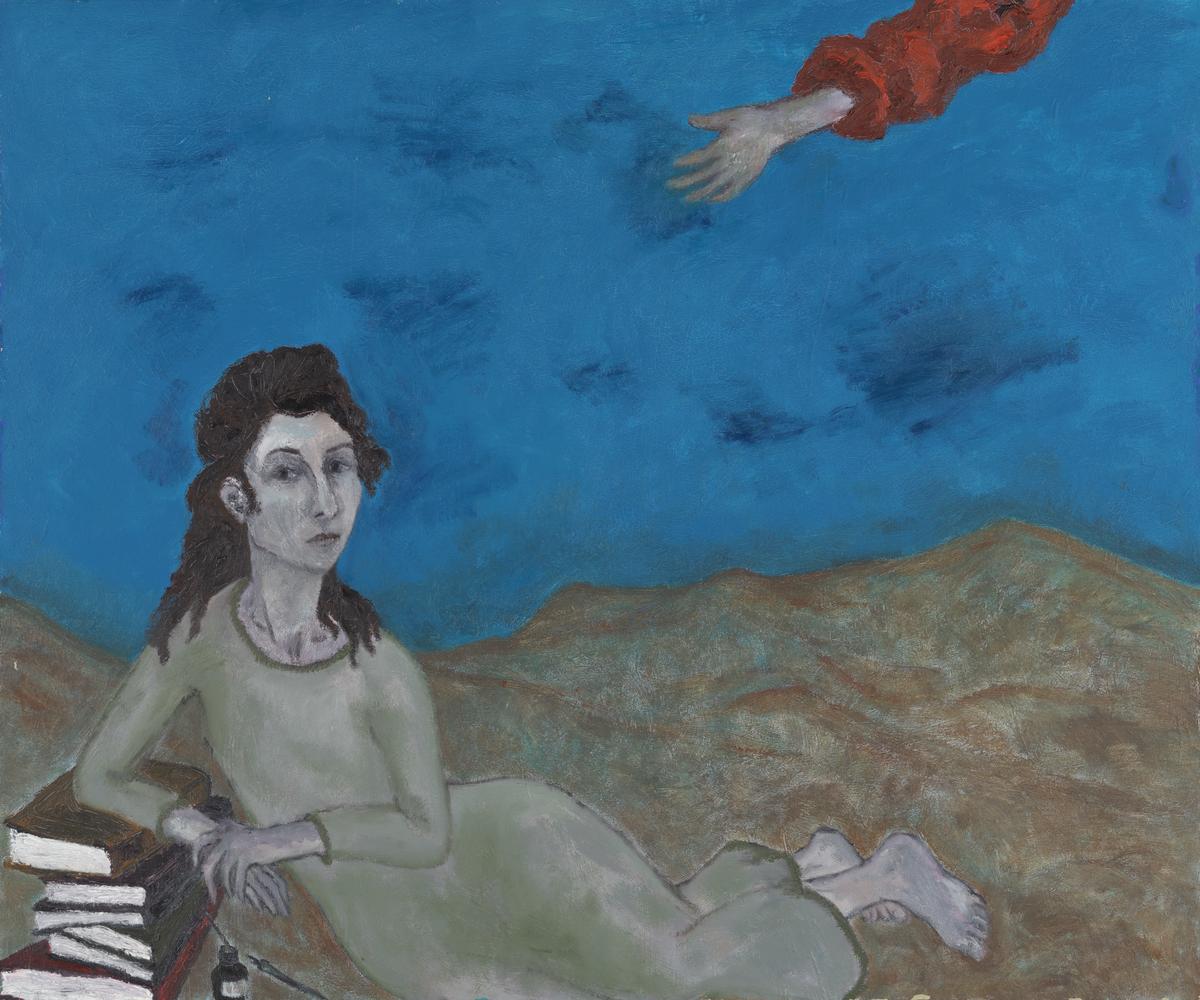
Partou Zia, 40 Nights and 40 Days 2008
40 Nights and 40 Days 2008 is a large painting in oil on canvas that shows an awkwardly reclining grey figure wearing a simple dress, gazing contemplatively out to her left. Her elbow is supported by a small stack of books, next to a pen and ink pot. The figure is lying on an uneven brown and grey ground beneath a vivid blue sky that dominates the upper half of the composition. A grey arm and hand in a loose red sleeve reaches down from the top edge. The figure is likely to be a self-portrait of the artist Partou Zia. Self-portraits were a particularly important aspect of Zia’s work in expressing her identity as a woman and painter. They also reflected her ongoing interest in the intuitive, spirituality and the development of self-knowledge. The title 40 Nights and 40 Days is a reversal of ‘40 Days and 40 Nights’, referencing multiple biblical stories. These include: forty days and nights of rain sent by God to destroy the earth (Book of Genesis); the period of time Moses was on Mount Sinai when he received the Ten Commandments from God (Book of Exodus); and the time Jesus spent fasting alone in the Judaean desert (Gospel of St Matthew). This work was painted in the final year of Zia’s life and was one of her last paintings. The application of oil paint in 40 Nights and 40 Days is more even and opaque than in earlier works by the artist, such as Flowering Rod 2006, also in Tate’s collection (Tate T15994).
1/30
artworks in Sixty Years: The Unfinished Conversation
Tish Murtha, Alleyway, Kenilworth Road from the series ‘Juvenile Jazz Bands’ 1979
This black and white photograph is from Tish Murtha’s series Juvenile Jazz Bands 1979. Murtha studied documentary photography in Newport, Wales, where she was taught by photographer David Hurn (born 1934), a member of the international photography cooperative Magnum Photos. She returned to the Newcastle area in 1978, capturing the impact of deindustrialisation, as well as the social and economic disadvantages of those living in her area, disadvantages which she had also experienced.
2/30
artworks in Sixty Years: The Unfinished Conversation
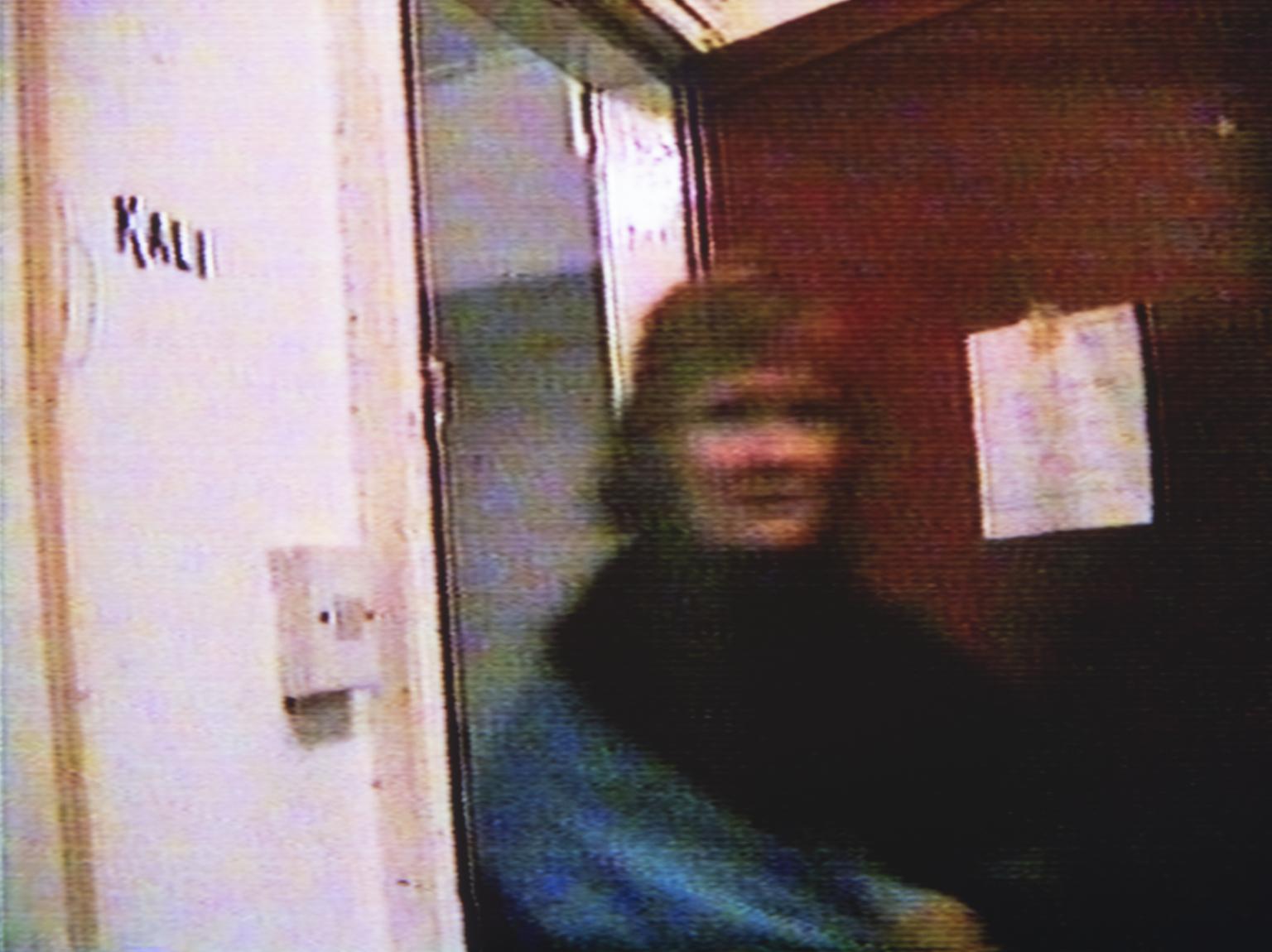
Sutapa Biswas, Kali 1983–1985
Kali documents a performance Biswas staged with Isabella Tracy. The artists play themselves and the characters Kali and Ravan from Hindu mythology. The film opens with an introduction from Biswas explaining that the characters of the performance enact a mythic struggle of good over evil. Kali represents a challenge to forces of ‘imperialism, cultural domination and exploitation of the East by the West’. As part of the performance, art historian Griselda Pollock sits on a chair wearing a hood. As a student, Biswas challenged Pollock for not engaging meaningfully with issues of race and colonialism while making space for discussion of gender and class. This exchange led Pollock to radically revise the Leeds University art history syllabus. Biswas notes, ‘I arrived and said: “You’ve got to change the course.” I was lucky because she listened’.
Gallery label, November 2023
3/30
artworks in Sixty Years: The Unfinished Conversation
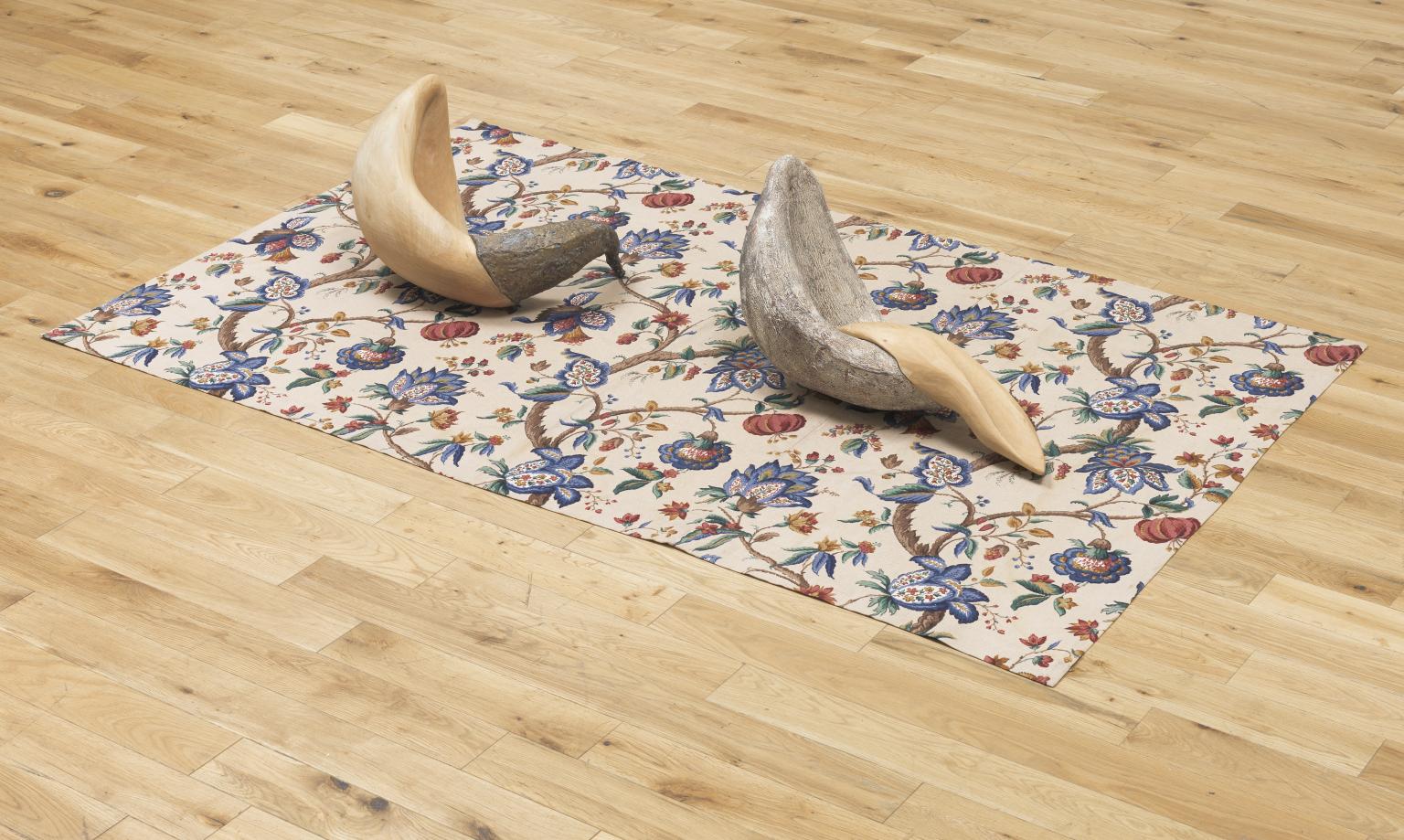
Jacqui Poncelet, Clay, bronze, wood and fabric 1988
This installation features both rigid and malleable materials. The objects sitting atop the fabric suggest soft flesh and intimate body parts, giving the work a sensual quality. Jacqui Poncelet’s sculptures from the 1980s were informed by her encounter with ninth-century Indian erotic stone sculptures at the British Museum. The floral pattern evokes the textiles often found in traditional English interiors. Yet, as Poncelet observes, ‘You know the way the English are such pirates. It is a Persian pattern that’s literally been adapted in an English manner’.
Gallery label, October 2025
4/30
artworks in Sixty Years: The Unfinished Conversation
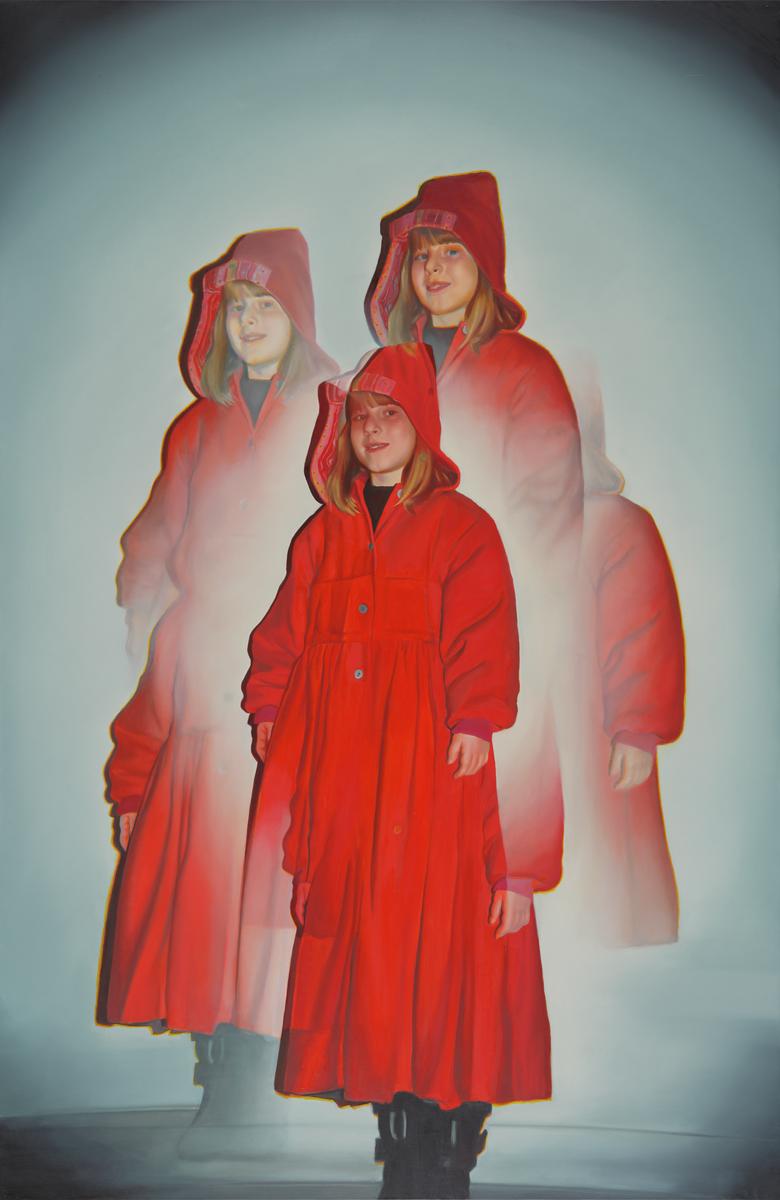
Allison Katz, Portrait of the artist as a young girl(s) 2022
5/30
artworks in Sixty Years: The Unfinished Conversation
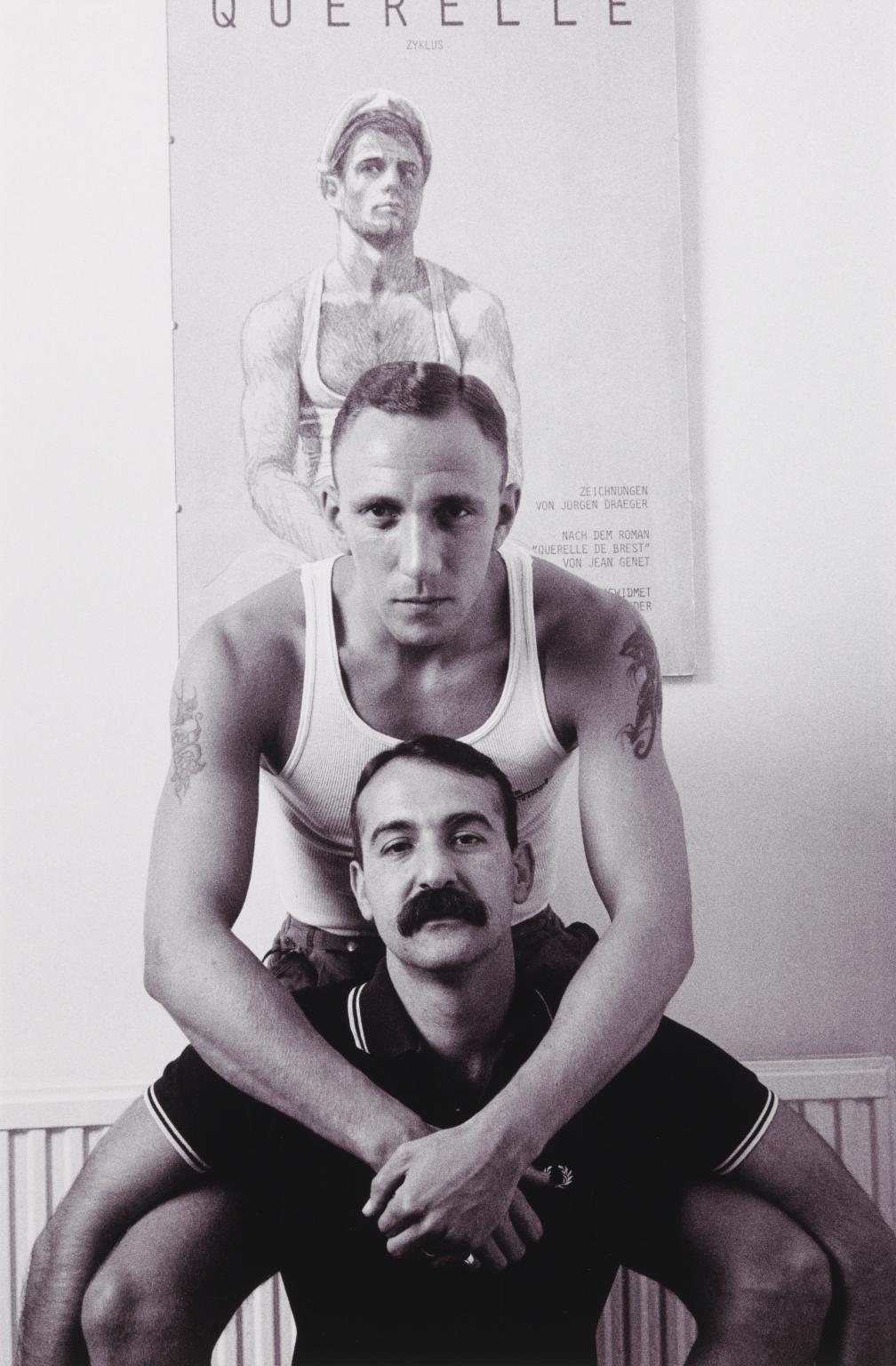
Sunil Gupta, Ian & Pavlik, London 1984, printed 2018
This series of black and white portraits features gay and lesbian couples from Sunil Gupta’s social circles in London and Newcastle. Called Lovers: Ten Years On, the project was shot over a period of two years from 1984–6, following the end of Gupta’s own ten-year relationship. Reminiscent of traditional family portraits, the photographs show couples in affectionate poses in their own living spaces. Prejudicial coverage of the HIV and AIDS epidemic in the 1980s threatened to turn public opinion against the acceptance of queer relationships, which were portrayed as ‘sexually deviant’. In contrast to these offensive depictions of queer love, the people in Lovers: Ten Years On are often presented as quite ordinary, middle-class, professional couples. Many of the people photographed would later lose their lives to HIV and AIDS.
Gallery label, January 2025
6/30
artworks in Sixty Years: The Unfinished Conversation
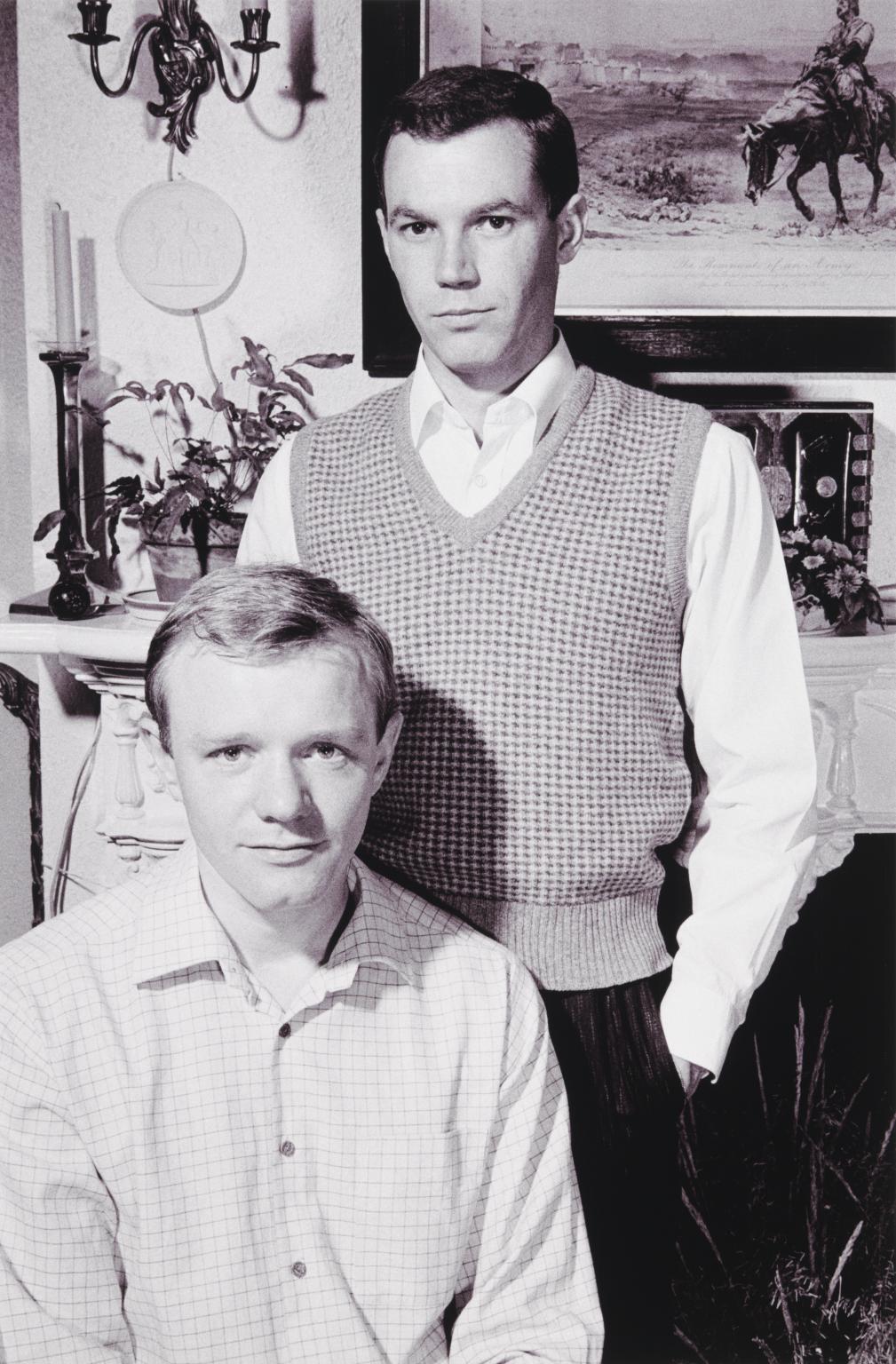
Sunil Gupta, Karl & Daniel, London 1985, printed 2018
This series of black and white portraits features gay and lesbian couples from Sunil Gupta’s social circles in London and Newcastle. Called Lovers: Ten Years On, the project was shot over a period of two years from 1984–6, following the end of Gupta’s own ten-year relationship. Reminiscent of traditional family portraits, the photographs show couples in affectionate poses in their own living spaces. Prejudicial coverage of the HIV and AIDS epidemic in the 1980s threatened to turn public opinion against the acceptance of queer relationships, which were portrayed as ‘sexually deviant’. In contrast to these offensive depictions of queer love, the people in Lovers: Ten Years On are often presented as quite ordinary, middle-class, professional couples. Many of the people photographed would later lose their lives to HIV and AIDS.
Gallery label, January 2025
7/30
artworks in Sixty Years: The Unfinished Conversation
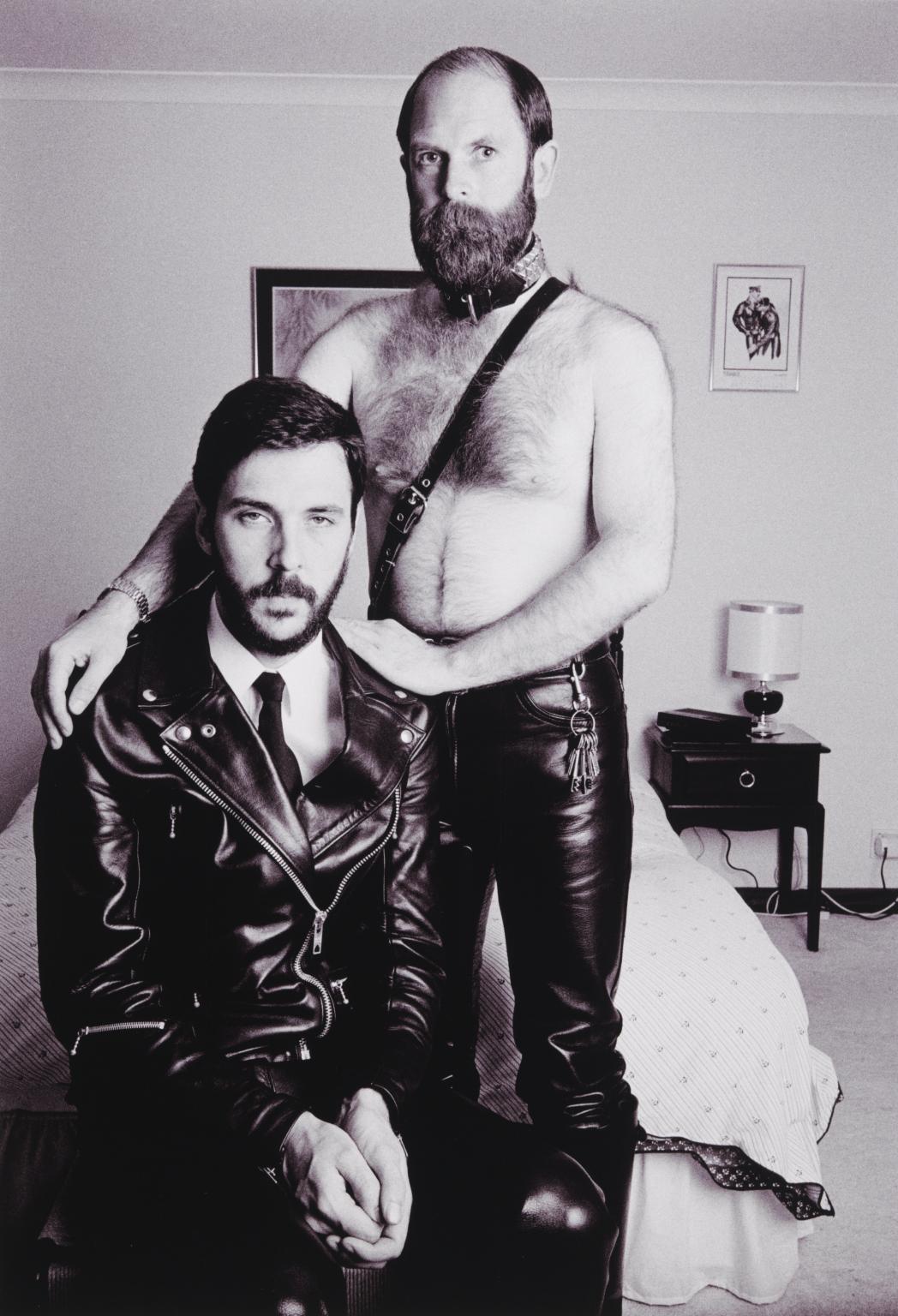
Sunil Gupta, Dylan & Gerald, London 1985, printed 2018
This series of black and white portraits features gay and lesbian couples from Sunil Gupta’s social circles in London and Newcastle. Called Lovers: Ten Years On, the project was shot over a period of two years from 1984–6, following the end of Gupta’s own ten-year relationship. Reminiscent of traditional family portraits, the photographs show couples in affectionate poses in their own living spaces. Prejudicial coverage of the HIV and AIDS epidemic in the 1980s threatened to turn public opinion against the acceptance of queer relationships, which were portrayed as ‘sexually deviant’. In contrast to these offensive depictions of queer love, the people in Lovers: Ten Years On are often presented as quite ordinary, middle-class, professional couples. Many of the people photographed would later lose their lives to HIV and AIDS.
Gallery label, January 2025
8/30
artworks in Sixty Years: The Unfinished Conversation
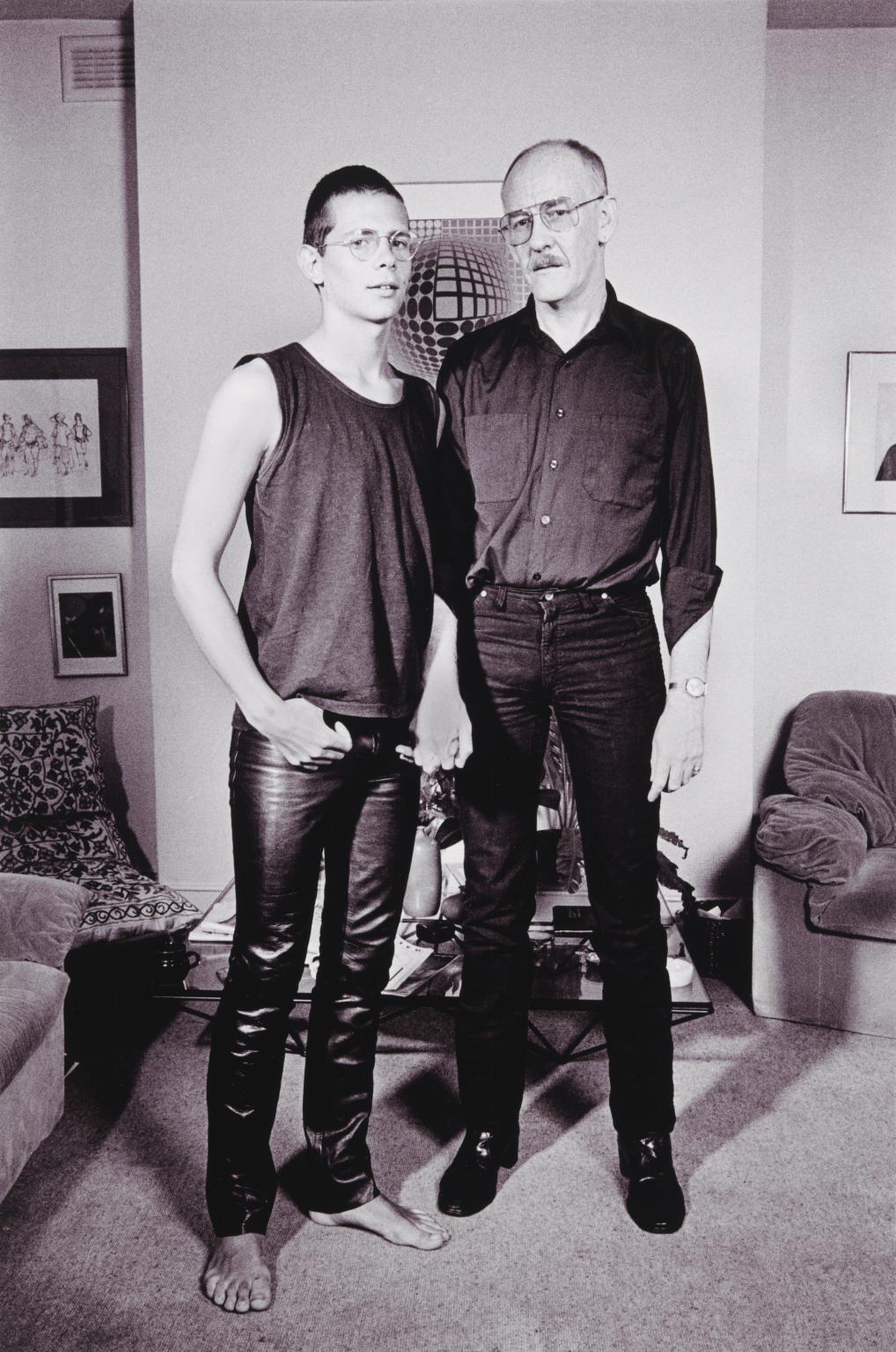
Sunil Gupta, Andrew & John, London 1985, printed 2018
This series of black and white portraits features gay and lesbian couples from Sunil Gupta’s social circles in London and Newcastle. Called Lovers: Ten Years On, the project was shot over a period of two years from 1984–6, following the end of Gupta’s own ten-year relationship. Reminiscent of traditional family portraits, the photographs show couples in affectionate poses in their own living spaces. Prejudicial coverage of the HIV and AIDS epidemic in the 1980s threatened to turn public opinion against the acceptance of queer relationships, which were portrayed as ‘sexually deviant’. In contrast to these offensive depictions of queer love, the people in Lovers: Ten Years On are often presented as quite ordinary, middle-class, professional couples. Many of the people photographed would later lose their lives to HIV and AIDS.
Gallery label, January 2025
9/30
artworks in Sixty Years: The Unfinished Conversation
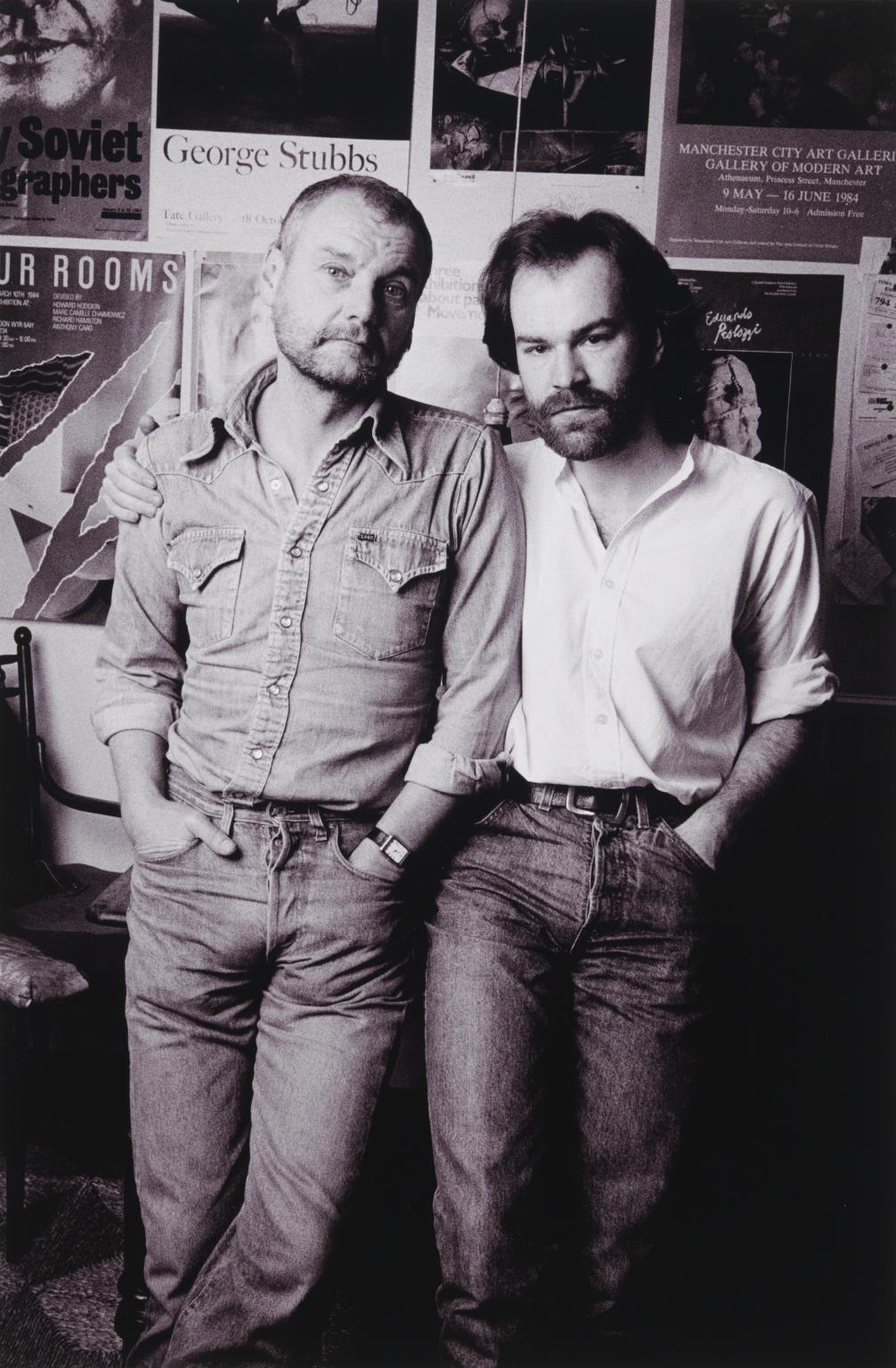
Sunil Gupta, Emmanuel & David, London 1984, printed 2018
This series of black and white portraits features gay and lesbian couples from Sunil Gupta’s social circles in London and Newcastle. Called Lovers: Ten Years On, the project was shot over a period of two years from 1984–6, following the end of Gupta’s own ten-year relationship. Reminiscent of traditional family portraits, the photographs show couples in affectionate poses in their own living spaces. Prejudicial coverage of the HIV and AIDS epidemic in the 1980s threatened to turn public opinion against the acceptance of queer relationships, which were portrayed as ‘sexually deviant’. In contrast to these offensive depictions of queer love, the people in Lovers: Ten Years On are often presented as quite ordinary, middle-class, professional couples. Many of the people photographed would later lose their lives to HIV and AIDS.
Gallery label, January 2025
10/30
artworks in Sixty Years: The Unfinished Conversation
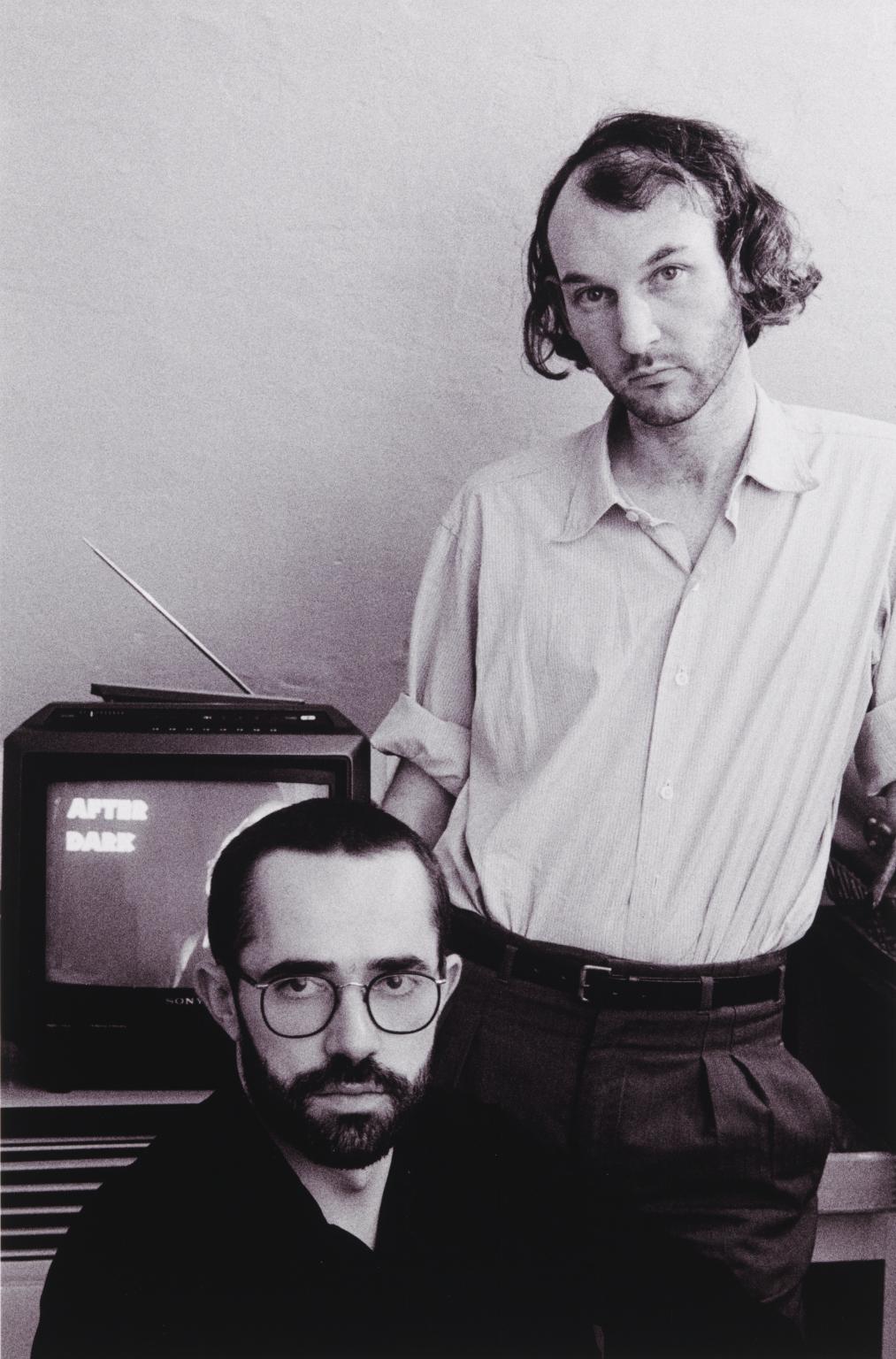
Sunil Gupta, Guy & Brian, London 1984, printed 2018
This series of black and white portraits features gay and lesbian couples from Sunil Gupta’s social circles in London and Newcastle. Called Lovers: Ten Years On, the project was shot over a period of two years from 1984–6, following the end of Gupta’s own ten-year relationship. Reminiscent of traditional family portraits, the photographs show couples in affectionate poses in their own living spaces. Prejudicial coverage of the HIV and AIDS epidemic in the 1980s threatened to turn public opinion against the acceptance of queer relationships, which were portrayed as ‘sexually deviant’. In contrast to these offensive depictions of queer love, the people in Lovers: Ten Years On are often presented as quite ordinary, middle-class, professional couples. Many of the people photographed would later lose their lives to HIV and AIDS.
Gallery label, January 2025
11/30
artworks in Sixty Years: The Unfinished Conversation
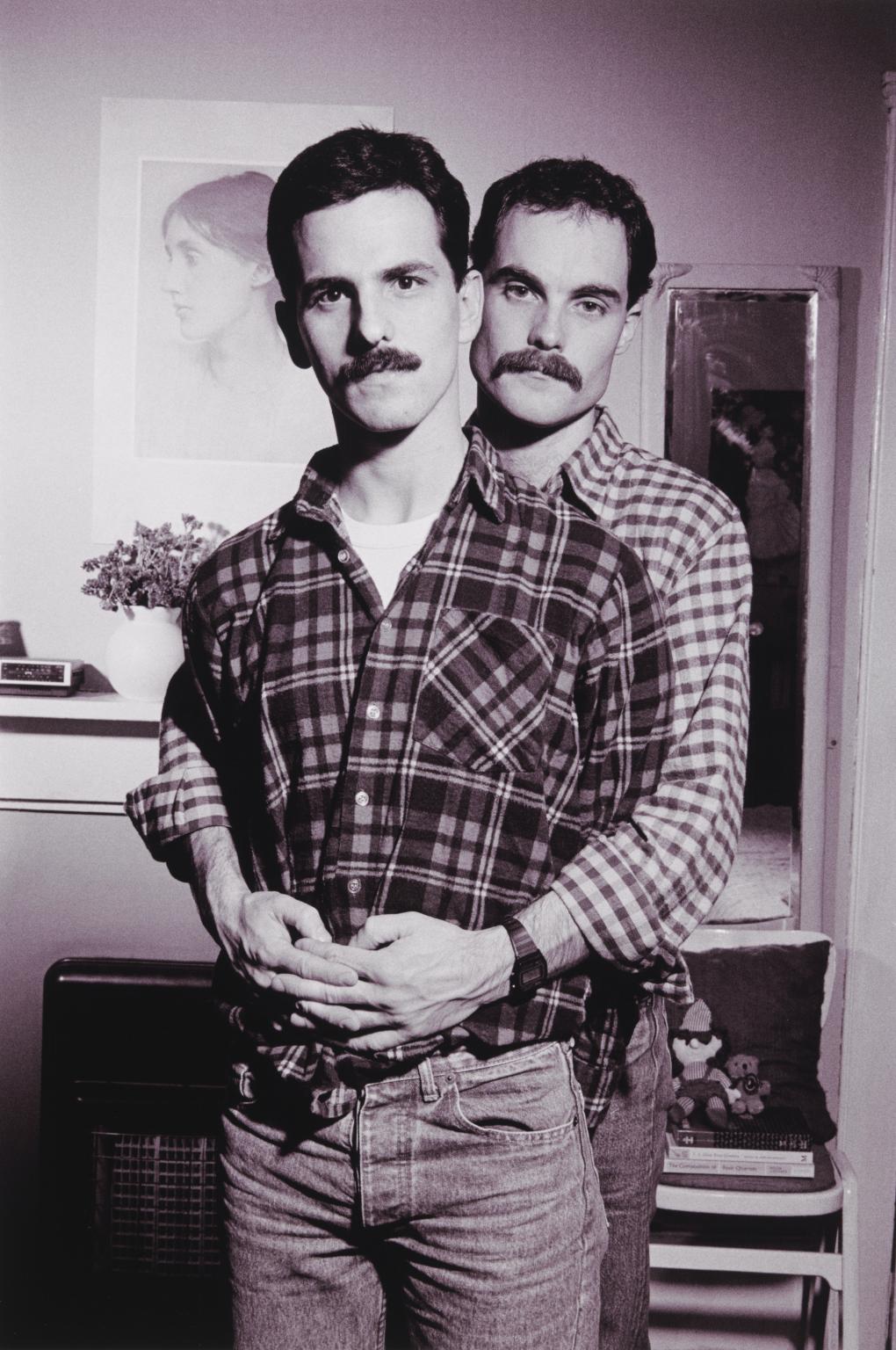
Sunil Gupta, Johnathan & Kim, London 1985, printed 2018
This series of black and white portraits features gay and lesbian couples from Sunil Gupta’s social circles in London and Newcastle. Called Lovers: Ten Years On, the project was shot over a period of two years from 1984–6, following the end of Gupta’s own ten-year relationship. Reminiscent of traditional family portraits, the photographs show couples in affectionate poses in their own living spaces. Prejudicial coverage of the HIV and AIDS epidemic in the 1980s threatened to turn public opinion against the acceptance of queer relationships, which were portrayed as ‘sexually deviant’. In contrast to these offensive depictions of queer love, the people in Lovers: Ten Years On are often presented as quite ordinary, middle-class, professional couples. Many of the people photographed would later lose their lives to HIV and AIDS.
Gallery label, January 2025
12/30
artworks in Sixty Years: The Unfinished Conversation

Sunil Gupta, Bruno & Daniel, London 1984, printed 2018
This series of black and white portraits features gay and lesbian couples from Sunil Gupta’s social circles in London and Newcastle. Called Lovers: Ten Years On, the project was shot over a period of two years from 1984–6, following the end of Gupta’s own ten-year relationship. Reminiscent of traditional family portraits, the photographs show couples in affectionate poses in their own living spaces. Prejudicial coverage of the HIV and AIDS epidemic in the 1980s threatened to turn public opinion against the acceptance of queer relationships, which were portrayed as ‘sexually deviant’. In contrast to these offensive depictions of queer love, the people in Lovers: Ten Years On are often presented as quite ordinary, middle-class, professional couples. Many of the people photographed would later lose their lives to HIV and AIDS.
Gallery label, January 2025
13/30
artworks in Sixty Years: The Unfinished Conversation
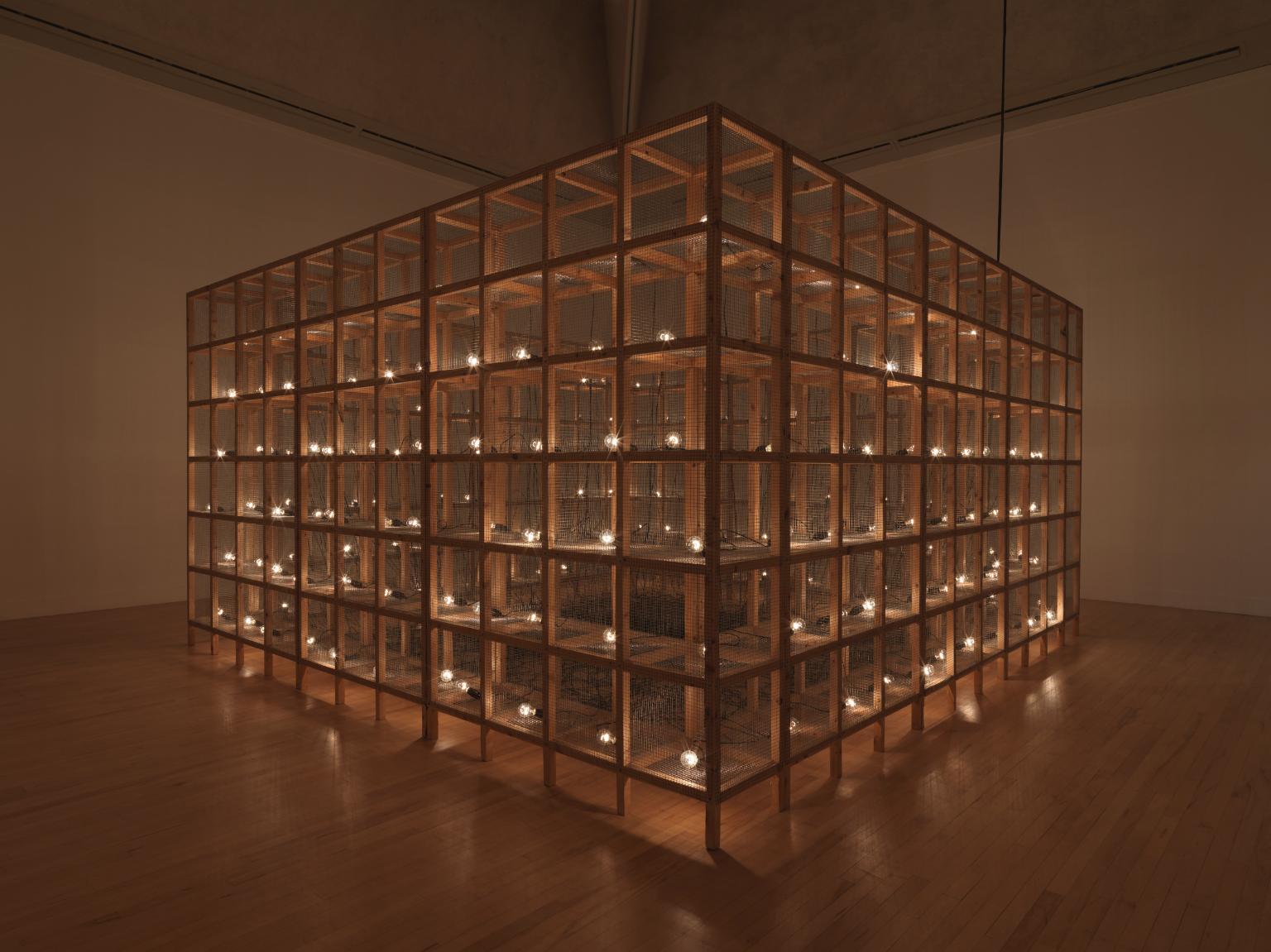
Mona Hatoum, Current Disturbance 1996
Referencing both the human body and rigid systems of abstraction, the installation Current Disturbance 1996 is made from an immense grid of over 200 cages, light bulbs and the amplified sound of electric currents. As the bulbs light up and fade out at irregular intervals, they sporadically illuminate the surrounding gallery. Inside each of the cages rests a single lightbulb, all interconnected via a central convergence. Another single bulb is suspended inside the structure, illuminating the junction box at the centre. The grid of metal cages sets up a contrast between the sense of systematization and the chaos of randomised flashing lights and the mess of wiring covering the floor. The tension arising from this juxtaposition of elements serves to intensify the feeling of suspended energy and instability, inspiring a certain discomfort in the viewer.
14/30
artworks in Sixty Years: The Unfinished Conversation

Rita Keegan, Homage to Frida Kahlo 1987
In this self-portrait, Rita Keegan stares out at the viewer. Her direct gaze recalls the self-portraits of Mexican painter Frida Kahlo (1907–1954). Cracks appear throughout her face, neck and chest. Portraiture and self-portraiture feature regularly in Keegan’s practice and are often references to her family photographs. Her extensive archive documents her Black middle-class Canadian family from the 1890s to the present day. Keegan moved to London in 1980 from the US and, in 1982, co-founded Brixton Art Gallery. She has spent her career working to support artists of colour.
Gallery label, January 2025
15/30
artworks in Sixty Years: The Unfinished Conversation
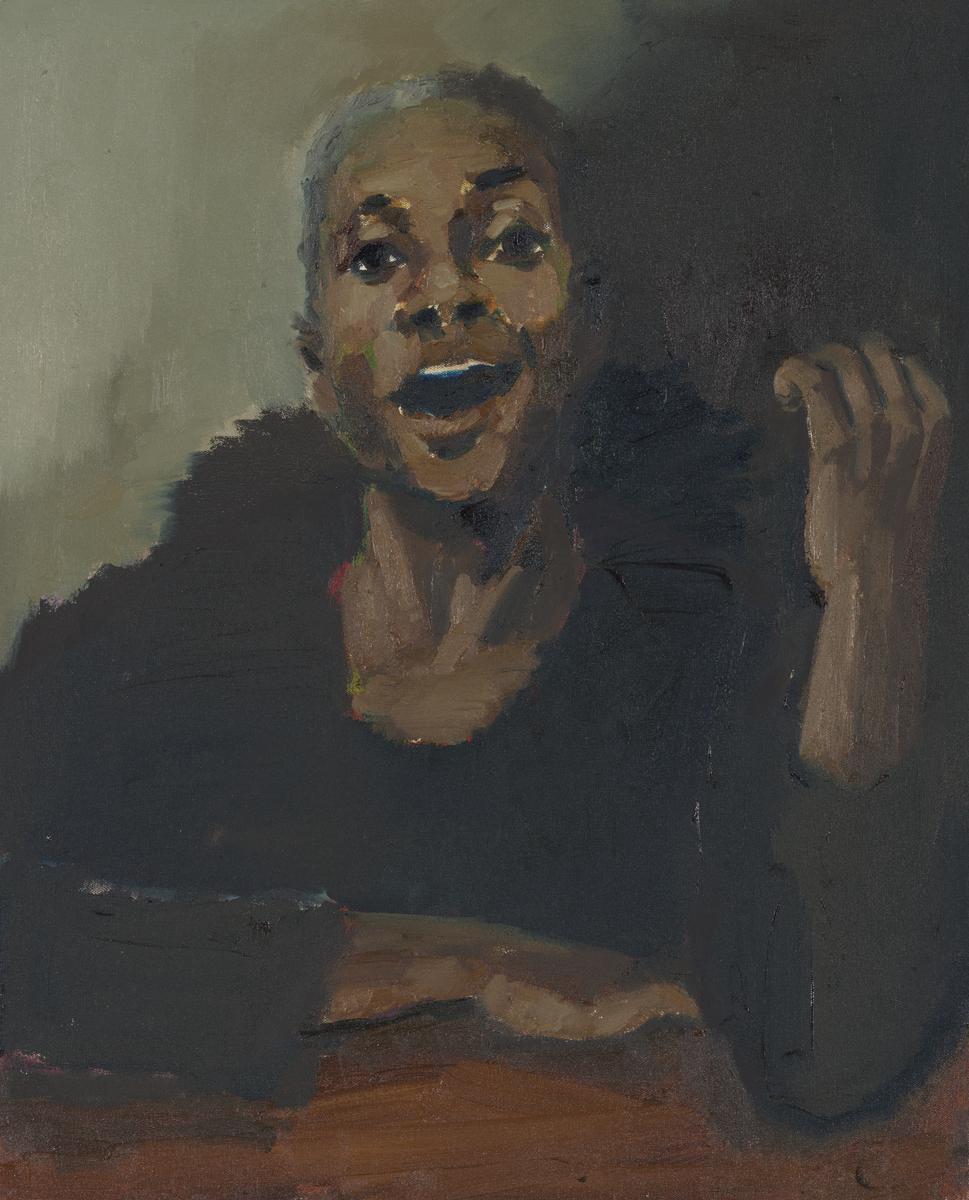
Lynette Yiadom-Boakye, Razorbill 2020
Razorbill 2020 is a small-scale oil painting of a single female figure with closely cropped hair. Her mouth is open as though caught mid-speech or song. Her upper body is clothed in near black, with a feathered ruffle at the collar. Her right forearm and left elbow rest on a tabletop. The motif of the carnivalesque ruff is one that reappears in Yiadom-Boakye’s work from 2009 onwards, in a number of paintings titled with bird names such as Les Corbeaux 2018, Greenfinch 2012 and Skylark 2010. Razorbill is closely related to these in its tones but is markedly different in its shift towards the looser brushwork and warmer palette that characterises Yiadom-Boakye’s work of 2020.
16/30
artworks in Sixty Years: The Unfinished Conversation
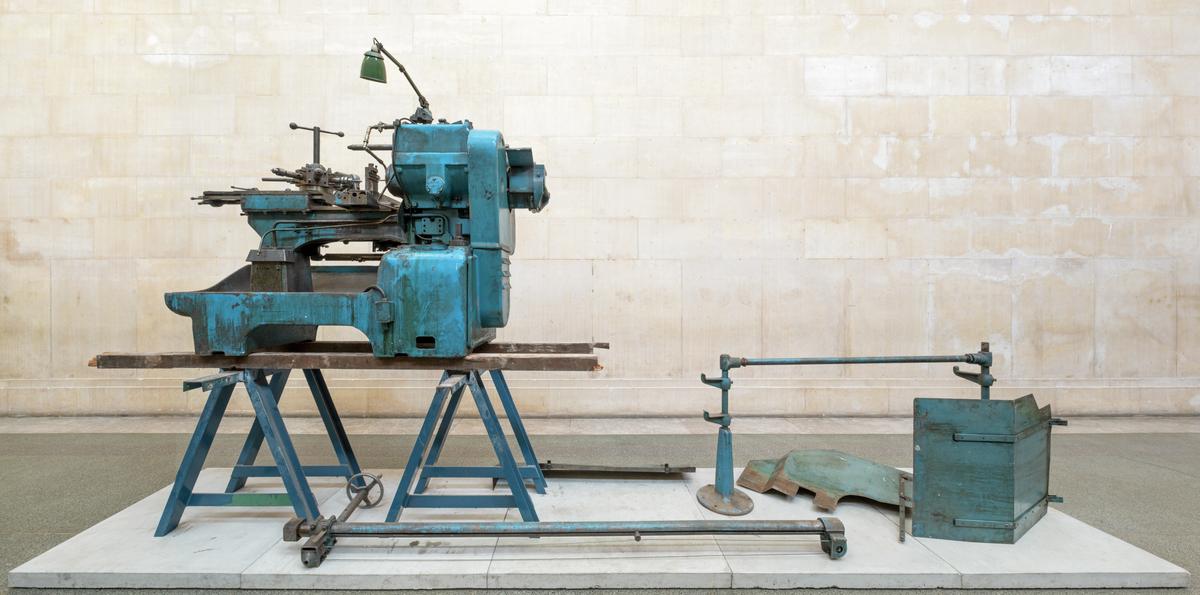
Mike Nelson, The Asset Strippers (Elephant) 2019
The Asset Strippers (Elephant) 2019 is a large sculptural assemblage made from reclaimed industrial items and materials. It was made as part of Mike Nelson’s larger project The Asset Stripers, his response to the Tate Britain Commission for the Duveen Galleries in 2019. A brilliant blue lathe balances on two wooden timbers on top of a pair of blue trestles. At the top of the lathe sits a dark green anglepoise lamp without a bulb. Positioned alongside at floor level are assorted lathe parts. Three of the parts lie horizontally, two stand upright. Each has been carefully placed in the manner of an archeological artefact or sculptural object, rather than an industrial machine part. The lathe and its component parts are placed on five abutting cast concrete slabs that together resemble a low-level traditional sculptural plinth. The compositional treatment of the parts, together with the monochromatic colour scheme, is reminiscent of British modernist sculpture, in particular the industrial assemblages of Anthony Caro (1924–2013). However, unlike much of Caro’s work, The Asset Strippers (Elephant) has not been painted or surface-treated. The patina of age and use of its reclaimed parts are visible in areas of rusting and traces of oil. Two other assemblages from The Asset Strippers are also in Tate’s collection: The Asset Strippers (Heygate stack, equivalent for a lost estate) 2019 (Tate T15412) and Double Drill (No. 15) 2019 (Tate T15411).
17/30
artworks in Sixty Years: The Unfinished Conversation
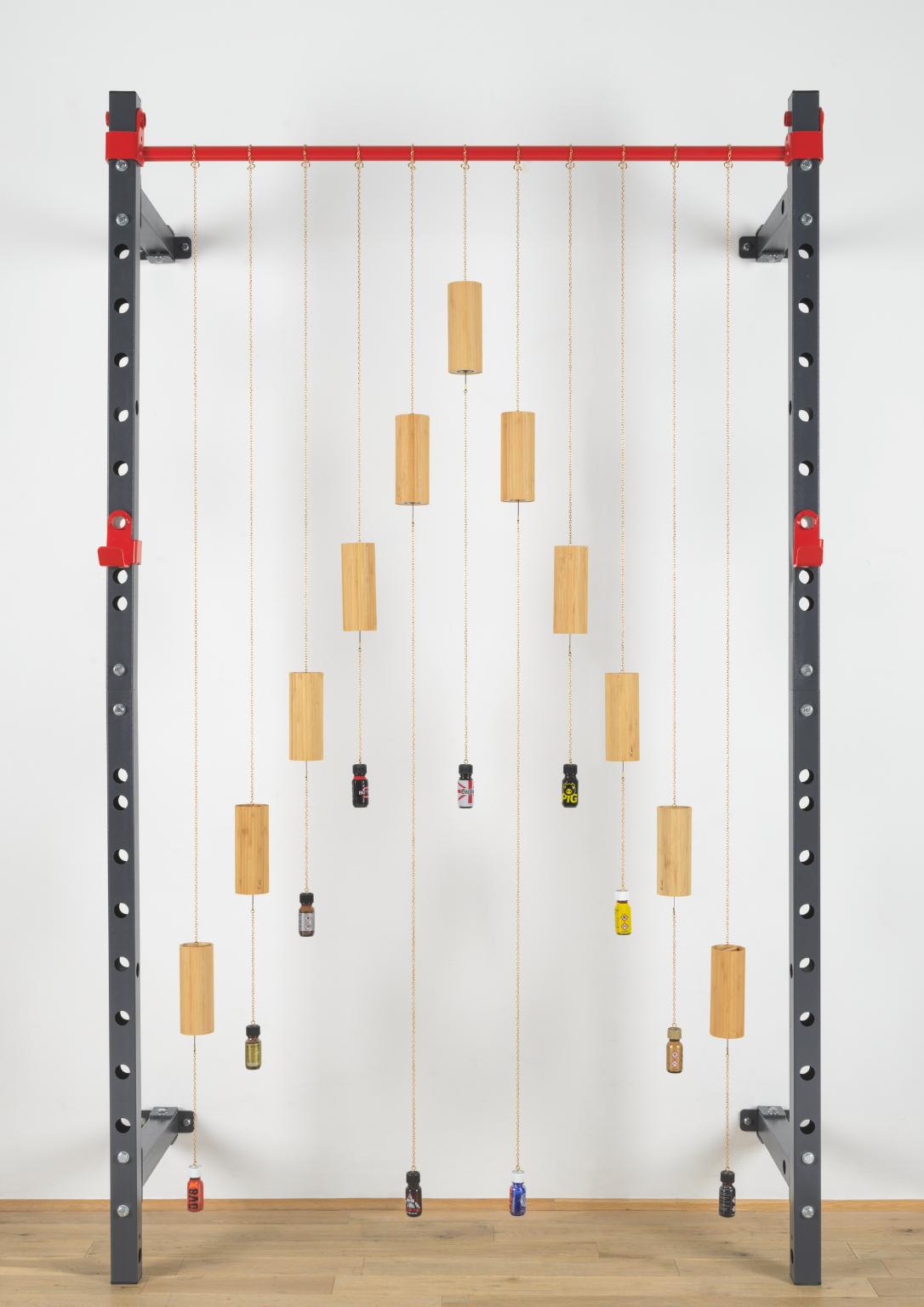
Adam Farah-Saad, Two traumatised young men connect whilst roaming the city of London, helping each other to survive…(THE INNER CHILDREN MIX) 2023
Adam Farah-Saad explores how love, loss and grief are held within personal and cultural objects. Here, empty bottles of poppers are suspended from a gym bar repurposed from his studio and weaved into chains. They act as Koshi wind chimes, an instrument often used in sound therapy and meditation. The work is a shrine to survival, reflecting on the artist’s relationship to addiction and healing. It draws on the artist’s memory of the unexpected relationship alluded to in the title. Farah-Saad describes his art as a ‘call out for human connection, through vulnerability, reminiscing/reflecting, spiritual criticality’.
This work is activated at intervals by a member of Tate staff.
Gallery label, January 2025
18/30
artworks in Sixty Years: The Unfinished Conversation
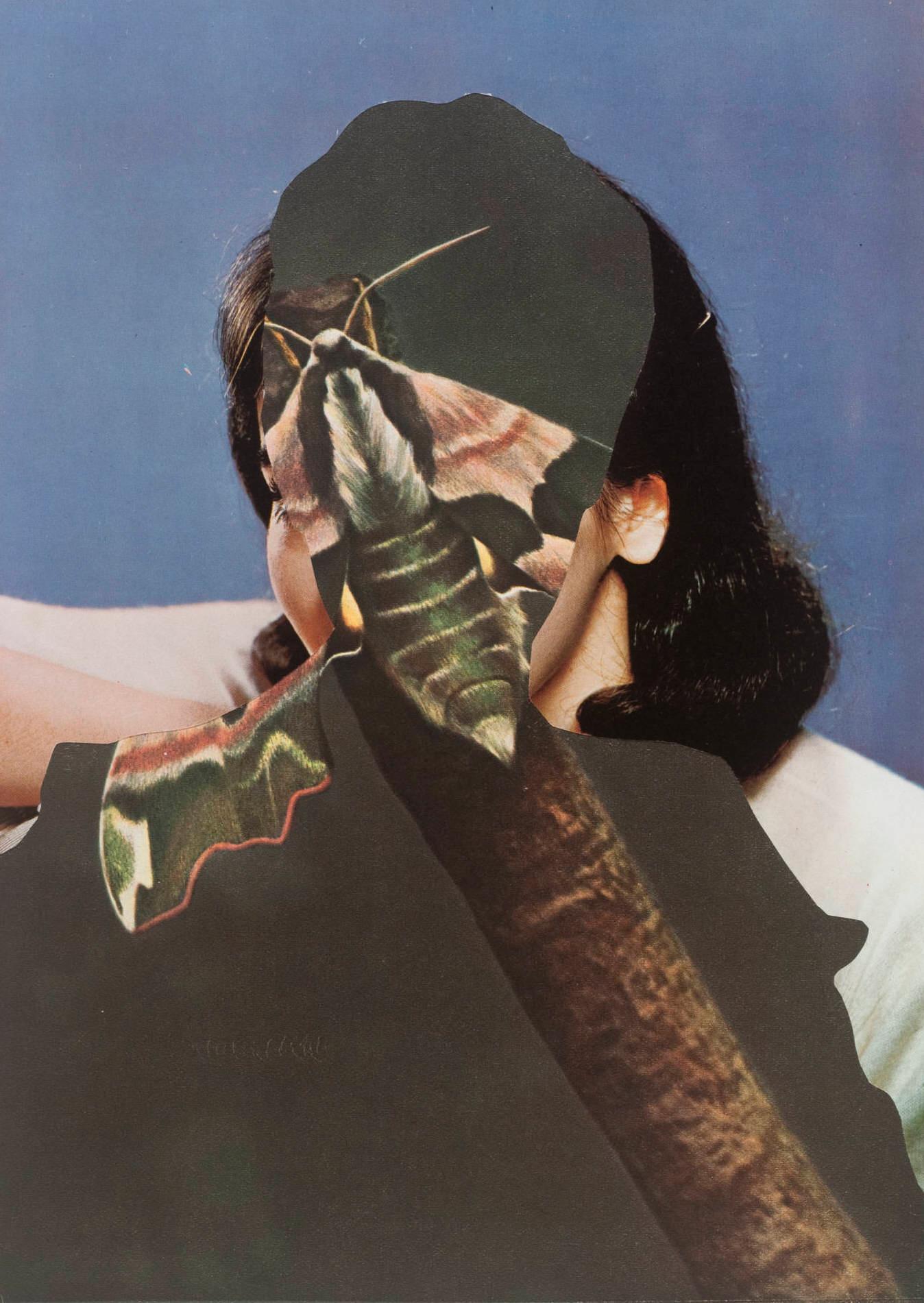
John Stezaker, Untitled 1989
Untitled is a collage combining three separate images. The principal image is a colour photograph of a film actress taken in the 1940s or 1950s. Her face has been excised by the silhouetted figure of another woman cut out of the paper on which the portrait was printed. The space of the silhouette is filled with a photographic reproduction of a moth on a branch. As is usual in a portrait, the photographed actress looks at the viewer but as a result of the artist’s intervention only her cheek, a few eyelashes and a sliver of eyebrow are visible on her right side and her jaw and ear on her left. Her right shoulder and part of her forearm are raised – she appears to be leaning on something. Stezaker’s collage obscures all the parts of her normally needed to read a portrait and in this sense the silhouetted figure operates like a mask – a concept central to Stezaker’s work (see Masks XI, XIII and XIV, 2005-6, T12345-7). The artist derived the image of the moth from an early colour photogravure, printed in a volume of The Natural World (a pre-war publication Stezaker found in a second hand book shop). The colours of its unusual markings – a delicate pink, white and two shades of brown – echo what we can see of the film actress’s skin tones, dark brown hair and white blouse or dress. The moth’s patterning covers most of the actress’s face with the uncanny effect of evoking a strange disfigurement. The artist has commented that the image reminds him ‘of that combination of the insectile and Victorian interiors in A.S.Byatt’s Morpho Eugenia (a short story printed in Angels and Insects, London 1992)’ (letter to the author 27 October 2007).
19/30
artworks in Sixty Years: The Unfinished Conversation
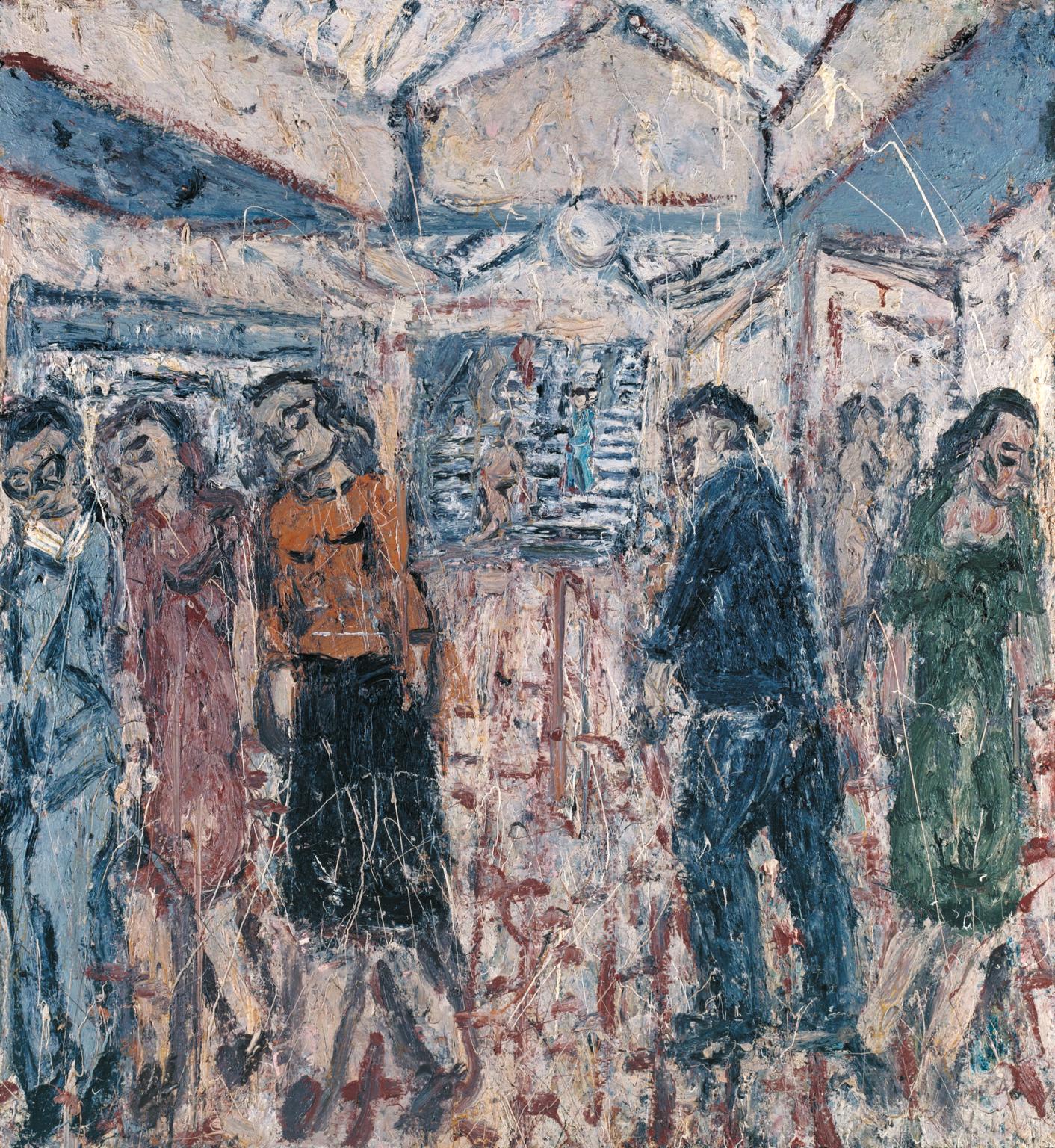
Leon Kossoff, Booking Hall, Kilburn Underground 1987
Kossoff’s principal subjects are his family and friends, and the parts of London best knownto him, and he reflected that, when painting public scenes, portraits of people close to him begin to appear within the crowd. This large painting belongs to a series depicting Kilburn Underground station in north London. Kossoff stated that ‘the shuddering feet of the sprawling city linger in my mind like a faintly glimmering memory of a long forgotten, perhaps never experienced childhood which, if rediscovered and illuminated, would ameliorate the pain of the present.’
Gallery label, September 2016
20/30
artworks in Sixty Years: The Unfinished Conversation
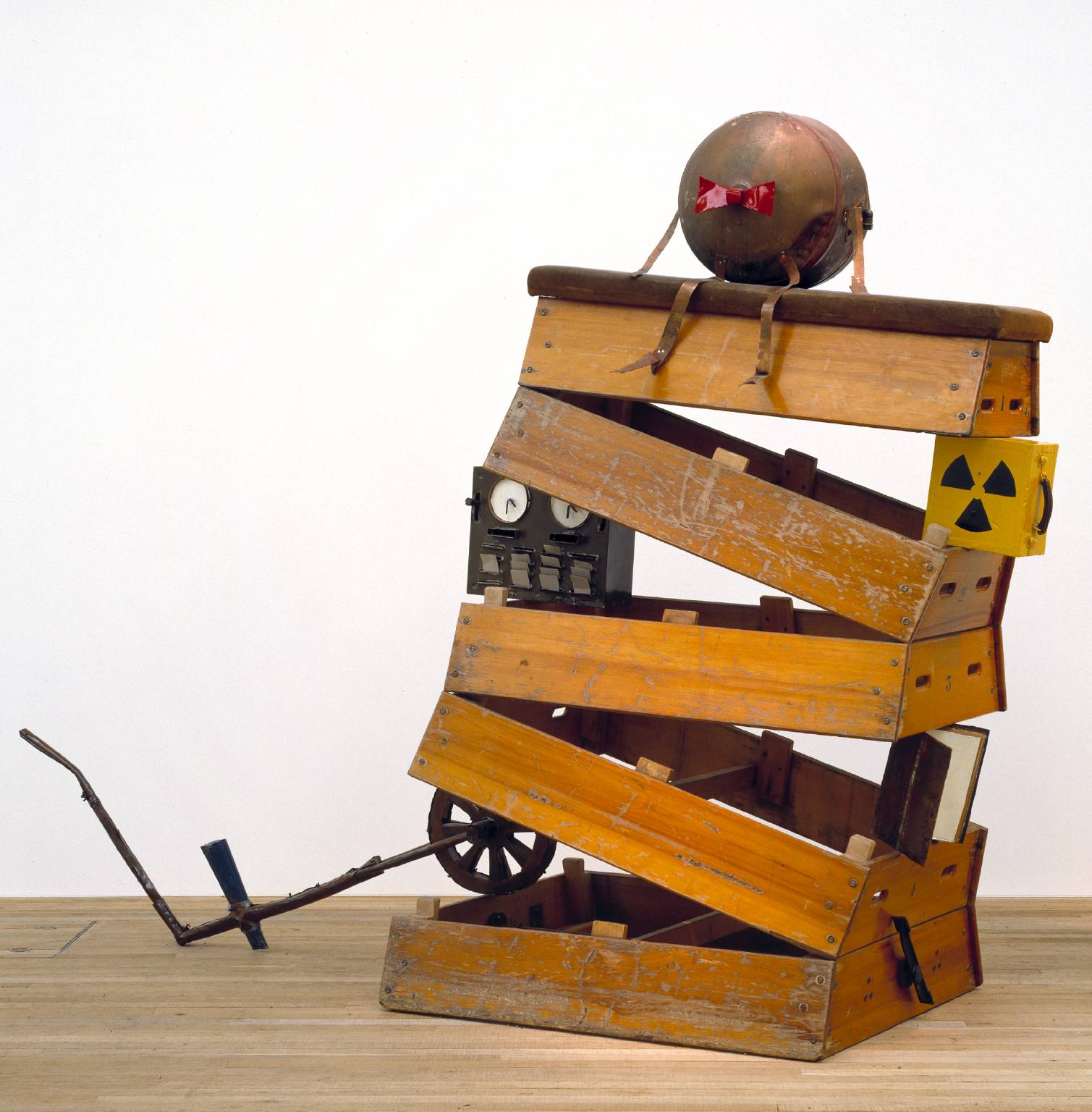
Bill Woodrow, English Heritage - Humpty Fucking Dumpty 1987
Wedged between the sections of a vaulting box are representations of a wheeled plough, a book, a clocking-in machine and a box with radiation hazard markings. This succession of objects symbolises human progress, creating what Woodrow calls 'a section through history'. At the top of the precarious structure sits the figure of Humpty Dumpty who, according to the nursery rhyme, 'sat on a wall' and 'had a great fall'. The ironic title English Heritage reflects Woodrow''s discomfort with the amount of jingoism in Britain during the 1980s, as well as a desire to question what actually constitutes his own heritage.
Gallery label, August 2004
21/30
artworks in Sixty Years: The Unfinished Conversation
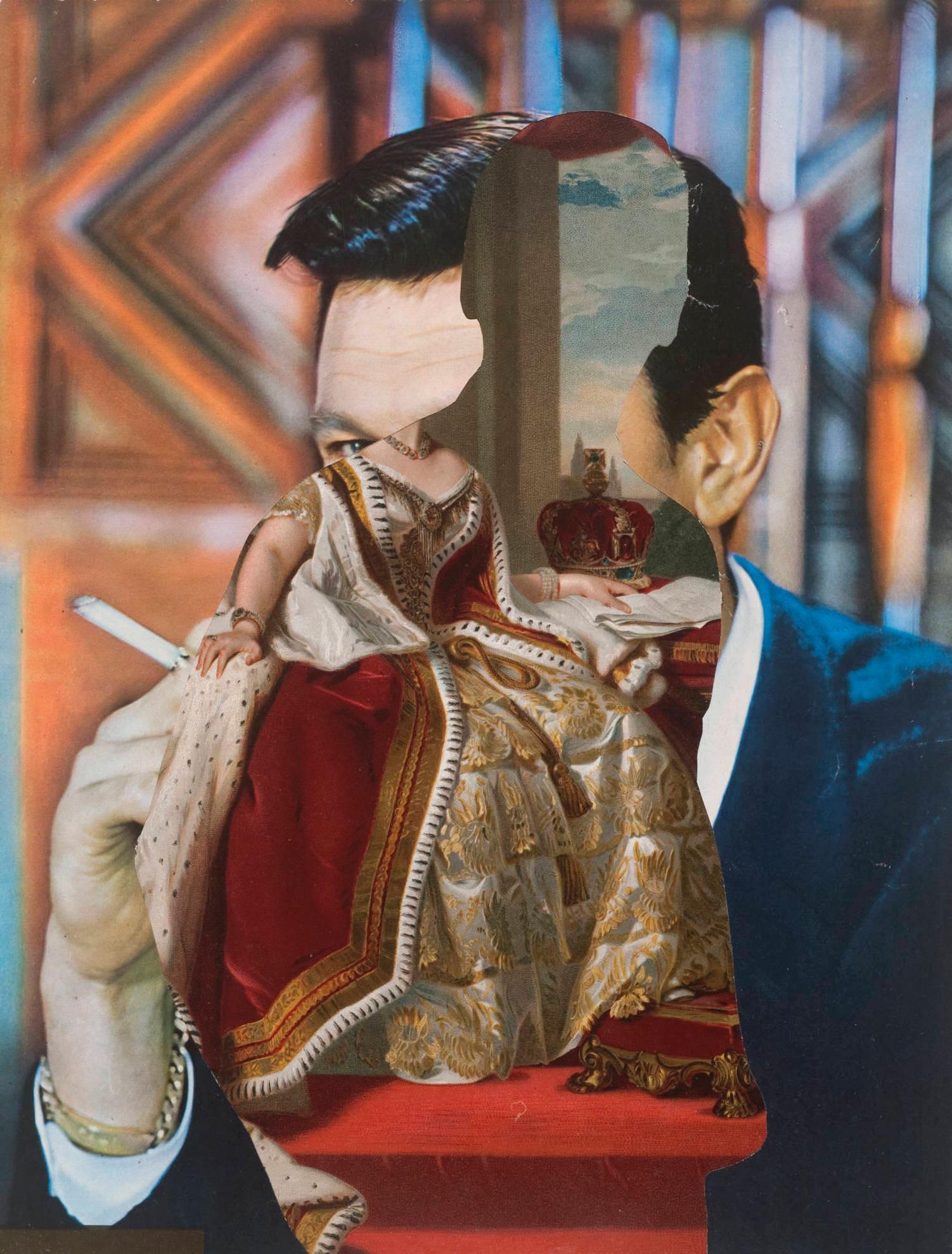
John Stezaker, Third Person 1988–9
Third Person is a collage combining three separate images. The principal image is a colour photograph of a film actor from the 1940s or 1950s. The silhouetted figure of another man has been cut out of this portrait, eliminating most of the actor’s face and chest, and the space has been filled with a reproduction of a painting of Queen Victoria. The outline of the second man cuts across the actor’s forehead and the corner of his right eye which looks out of the image at the viewer. His right hand, raised close to his face, is bisected by the collaged addition; it holds a cigarette that emerges from the point where the actor’s fingers meet the hand of Queen Victoria, lying on her ermine robes. The outline of the silhouetted male figure cuts off her head at the neck; the line of her necklace extends the line of the smoking actor’s right eyebrow. The silhouetted figure’s head is half filled with the image of a rich blue sky in which clouds are warmly illuminated in orange shades that complement the queen’s skin tones and the flesh tones of the smoking actor. The blue sky echoes highlights of blue light in the smoking actor’s black hair and on his dark jacket. These complimentary colours – shades of orange and electric blue – are repeated in the out of focus orange and blue patterning on the wall behind the actor.
22/30
artworks in Sixty Years: The Unfinished Conversation

Sunil Gupta, Roger & Steve, London 1984, printed 2018
This series of black and white portraits features gay and lesbian couples from Sunil Gupta’s social circles in London and Newcastle. Called Lovers: Ten Years On, the project was shot over a period of two years from 1984–6, following the end of Gupta’s own ten-year relationship. Reminiscent of traditional family portraits, the photographs show couples in affectionate poses in their own living spaces. Prejudicial coverage of the HIV and AIDS epidemic in the 1980s threatened to turn public opinion against the acceptance of queer relationships, which were portrayed as ‘sexually deviant’. In contrast to these offensive depictions of queer love, the people in Lovers: Ten Years On are often presented as quite ordinary, middle-class, professional couples. Many of the people photographed would later lose their lives to HIV and AIDS.
Gallery label, January 2025
23/30
artworks in Sixty Years: The Unfinished Conversation
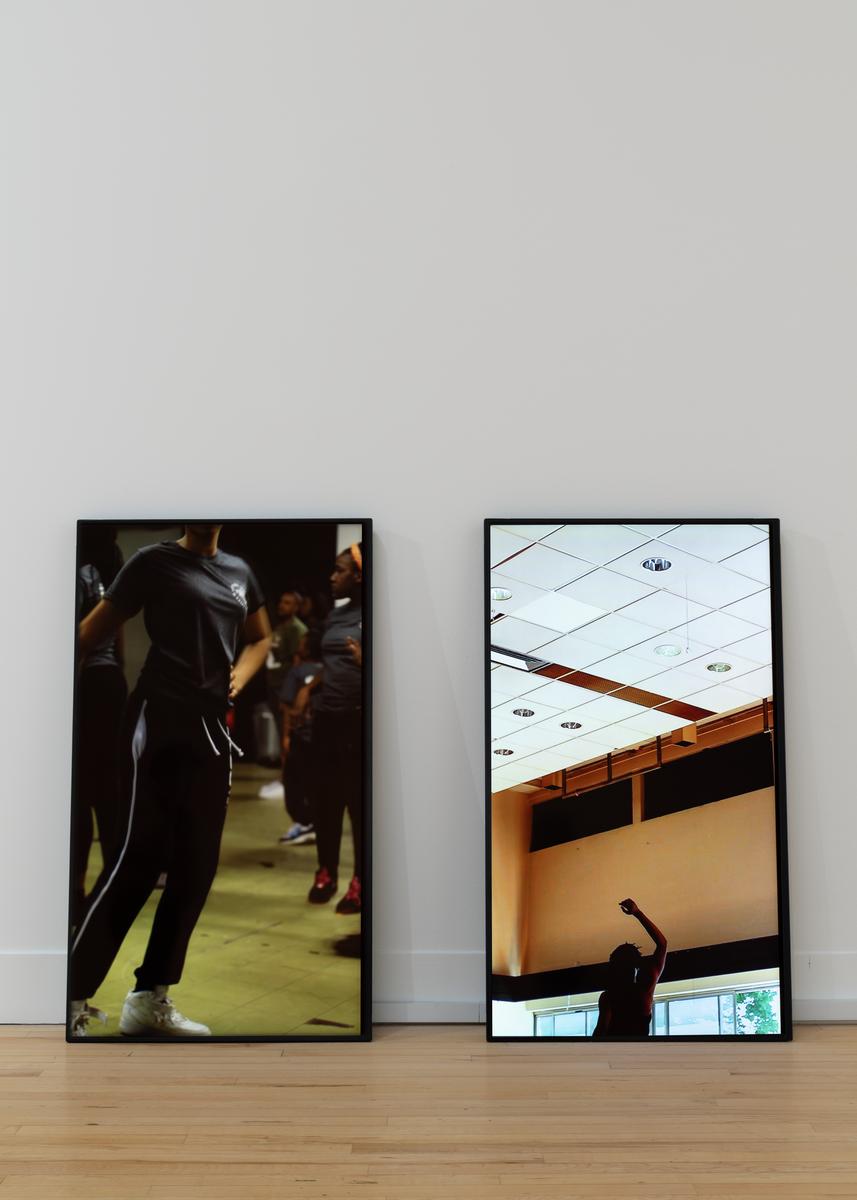
Paul Maheke, Mutual Survival, Lorde’s Manifesto 2015
Mutual Survival, Lorde’s Manifesto 2015 is a two-channel colour video installation presented on two floor-based forty-two-inch LED smart screens displayed leaning against a wall. The work’s title references the American Black feminist writer and activist Audre Lorde (1934–1992) whose words, borrowed and edited together from her essay ‘I am Your Sister’ published in 1985, caption the video intermittently. ‘As a people, we should most certainly work together to end our common oppression,’ the video subtitle begins. ‘We need to join our differences and articulate our particular strengths in the service of our mutual survivals.’ The work lasts seventeen minutes and fifteen seconds and exists in an edition of five. Tate’s copy is number one in the edition.
24/30
artworks in Sixty Years: The Unfinished Conversation
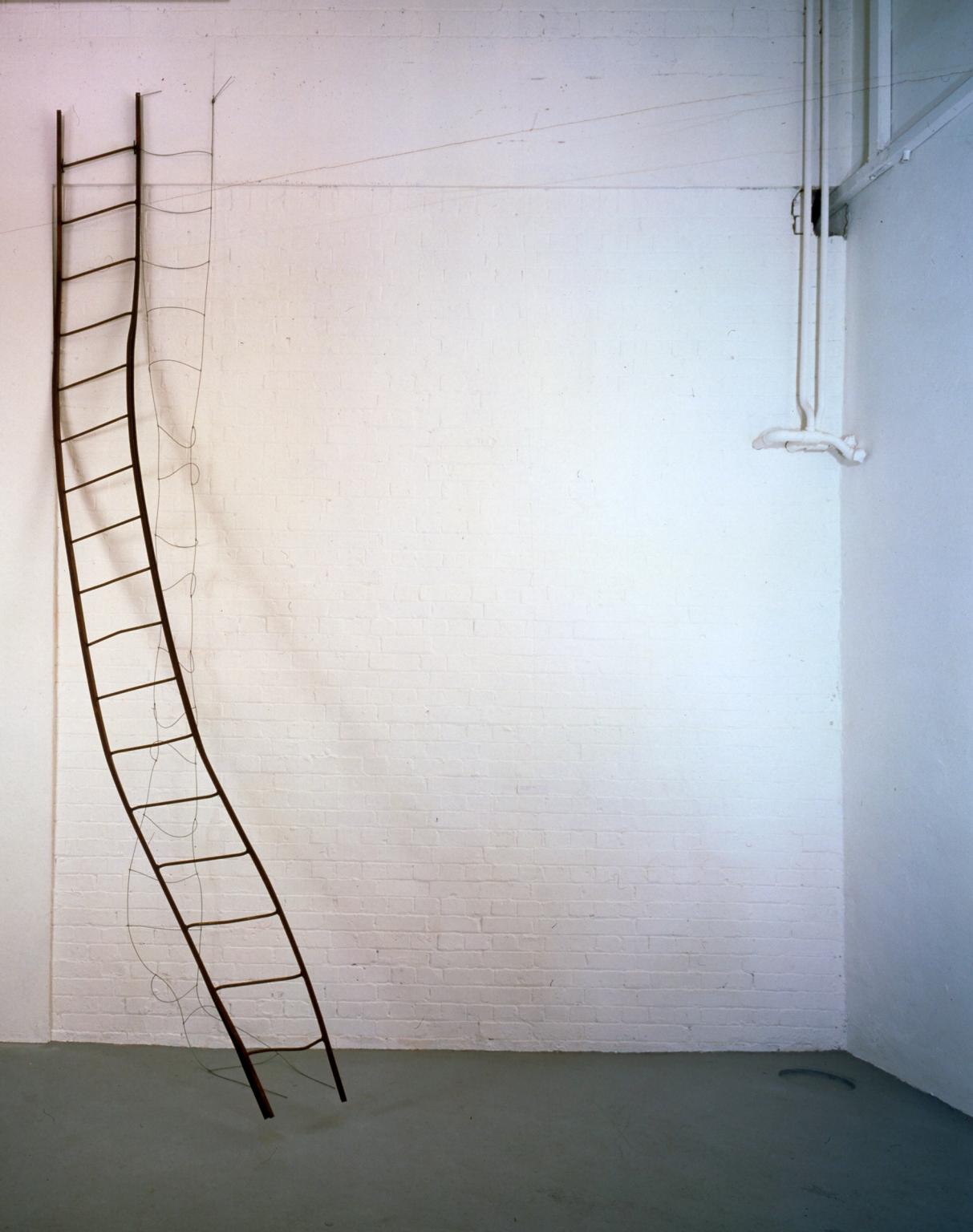
Richard Wentworth, 35°9,32°18 1985
Richard Wentworth had initially retrieved this ladder from a scrap heap, having been drawn to its sculptural quality. Behind it, a more fragile cable ladder emerges like a ghostly presence. The title is a map reference. Wentworth explained that it emerged from a conversation with a former Philosophy student, whom he had asked if it were possible to locate the ladder that connects heaven and earth, as described in Jacob’s dream in the Bible (Genesis 28,10). The student replied, ‘Oh yes’, and presented Wentworth with a grid reference the following morning.
Gallery label, November 2025
25/30
artworks in Sixty Years: The Unfinished Conversation
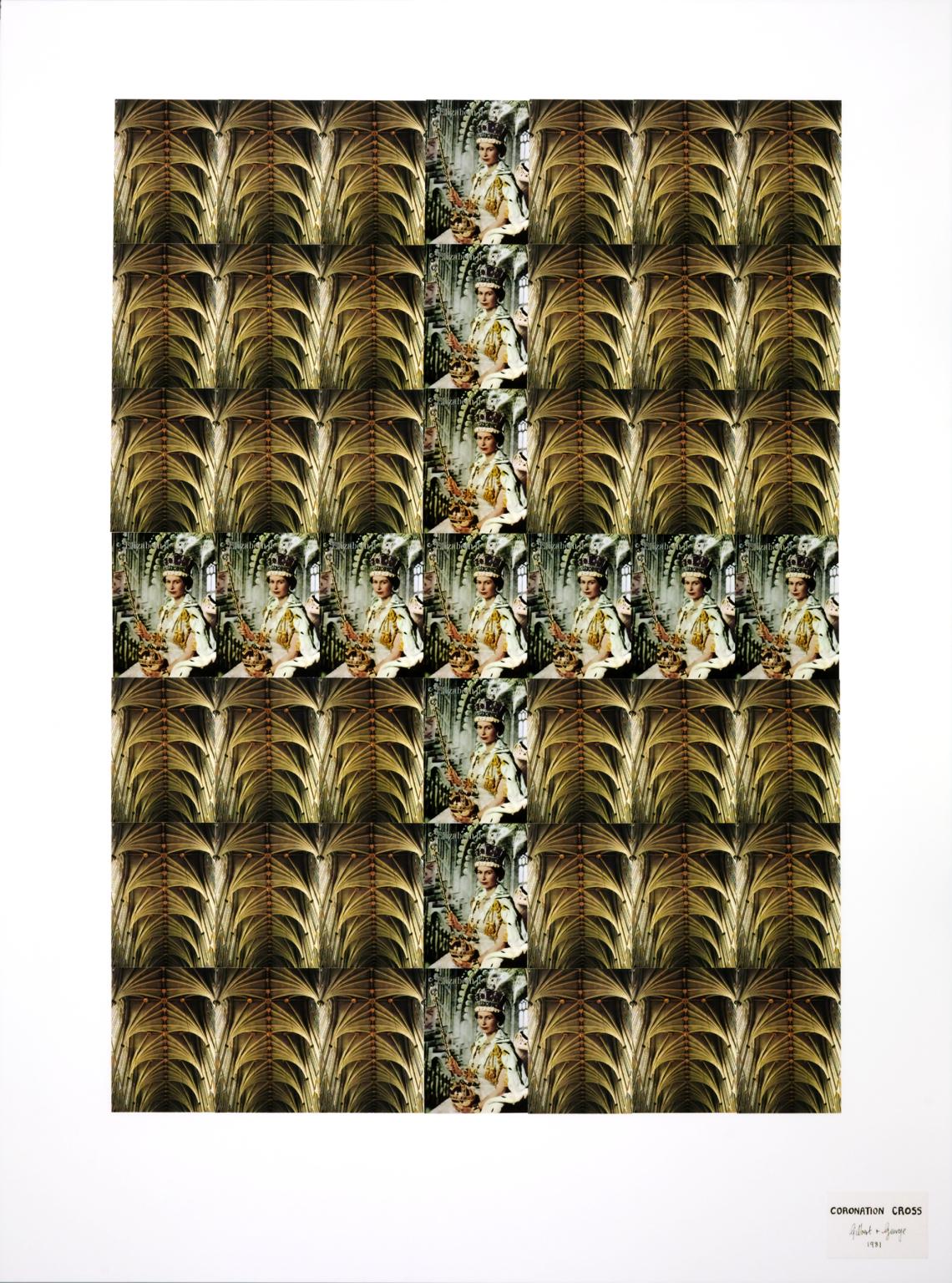
Gilbert & George, Coronation Cross 1981
This artwork is composed of postcards laid out in a rectangular grid, forming the outline of the English flag. The cross consists of 13 identical portraits of the late Queen Elizabeth II on Coronation Day in 1953, taken by British photographer, Cecil Beaton (1904–1980). The Queen holds the Sovereign’s Orb and the Sceptre of the Cross, symbols of monarchical authority, whilst the surrounding postcards show the vaulting in Westminster Abbey. By using the postcard, a simple and easily found material, the artists democratise traditional markers of British nationhood.
Gallery label, October 2025
26/30
artworks in Sixty Years: The Unfinished Conversation
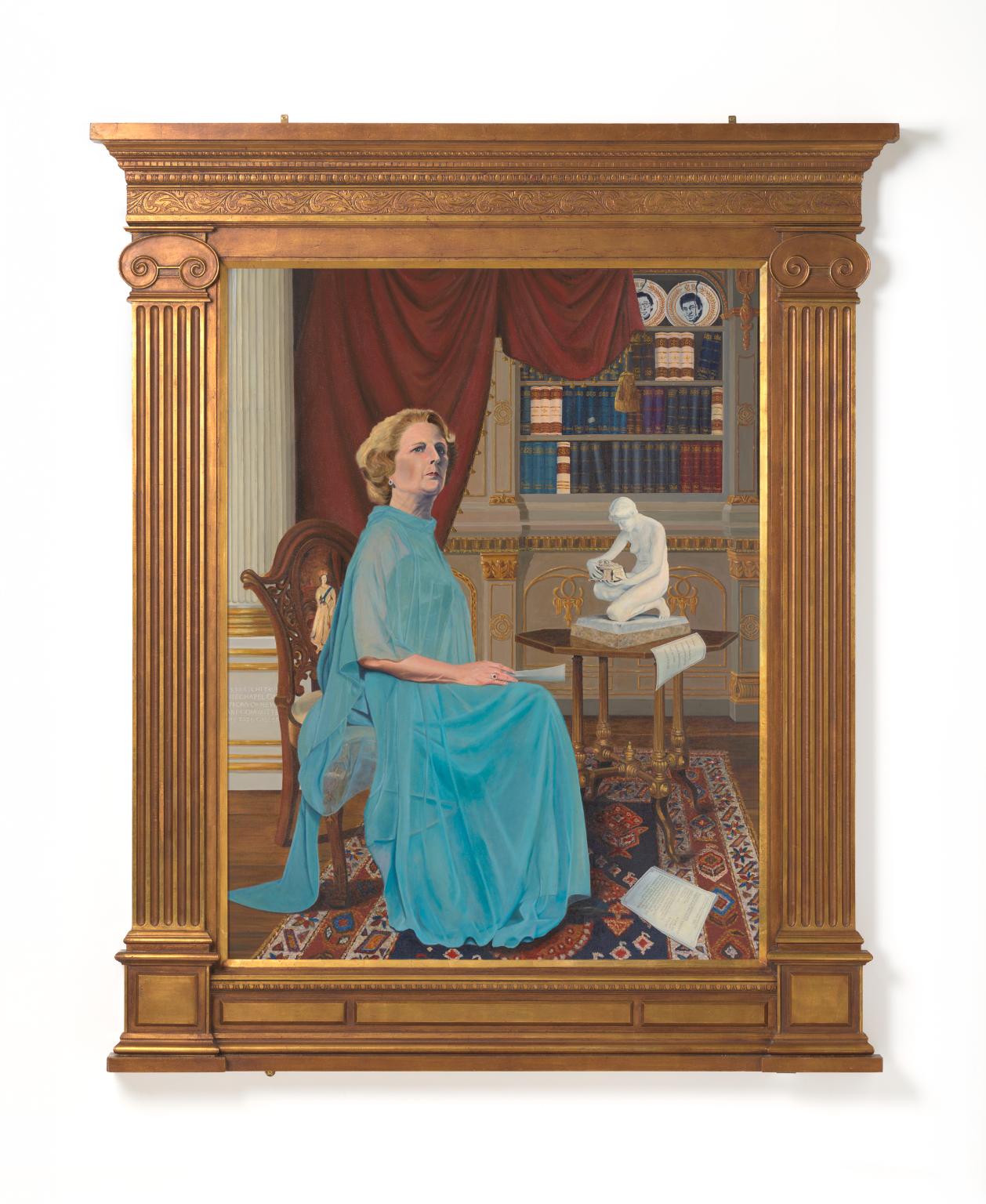
Hans Haacke, Taking Stock (unfinished) 1983–4
Hans Haacke depicts Margaret Thatcher, the Conservative UK Prime Minister from 1979–1990. Haacke designed the gilded frame based on 19th century paintings in Tate’s collection. The white statue on the table (also owned by Tate) is of Pandora from Greek mythology, who opened a box unleashing evil and misfortune into the world. The plates on the bookshelf are portraits of the founders of Saatchi & Saatchi, an advertising agency. Charles Saatchi was a patron of Tate and Saatchi & Saatchi produced Thatcher’s election campaigns. Through these and other references, Haacke exposes the entangled networks of politics, art and corporate finance.
Gallery label, December 2025
27/30
artworks in Sixty Years: The Unfinished Conversation
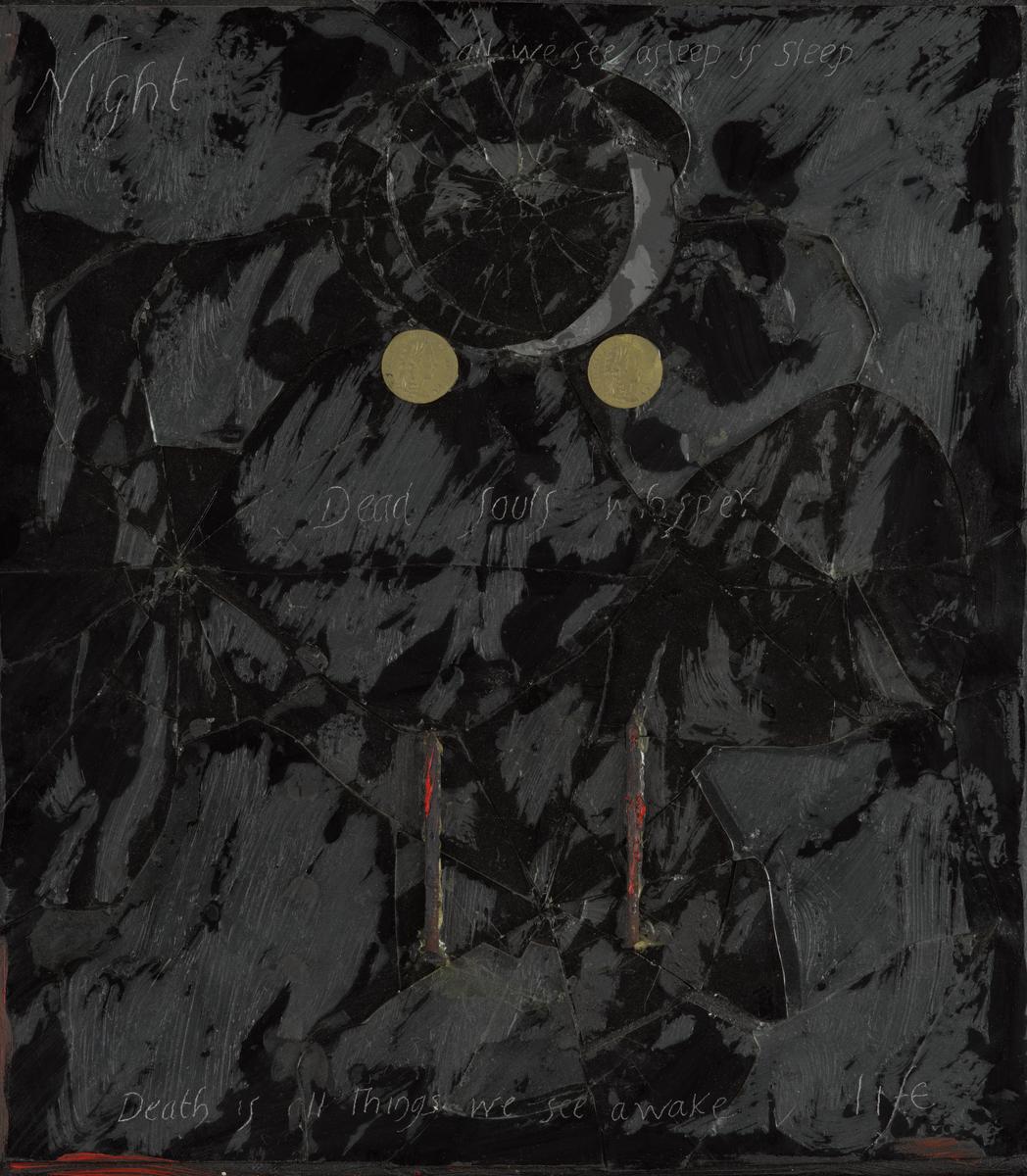
Derek Jarman, Dead Man’s Eyes 1987
28/30
artworks in Sixty Years: The Unfinished Conversation
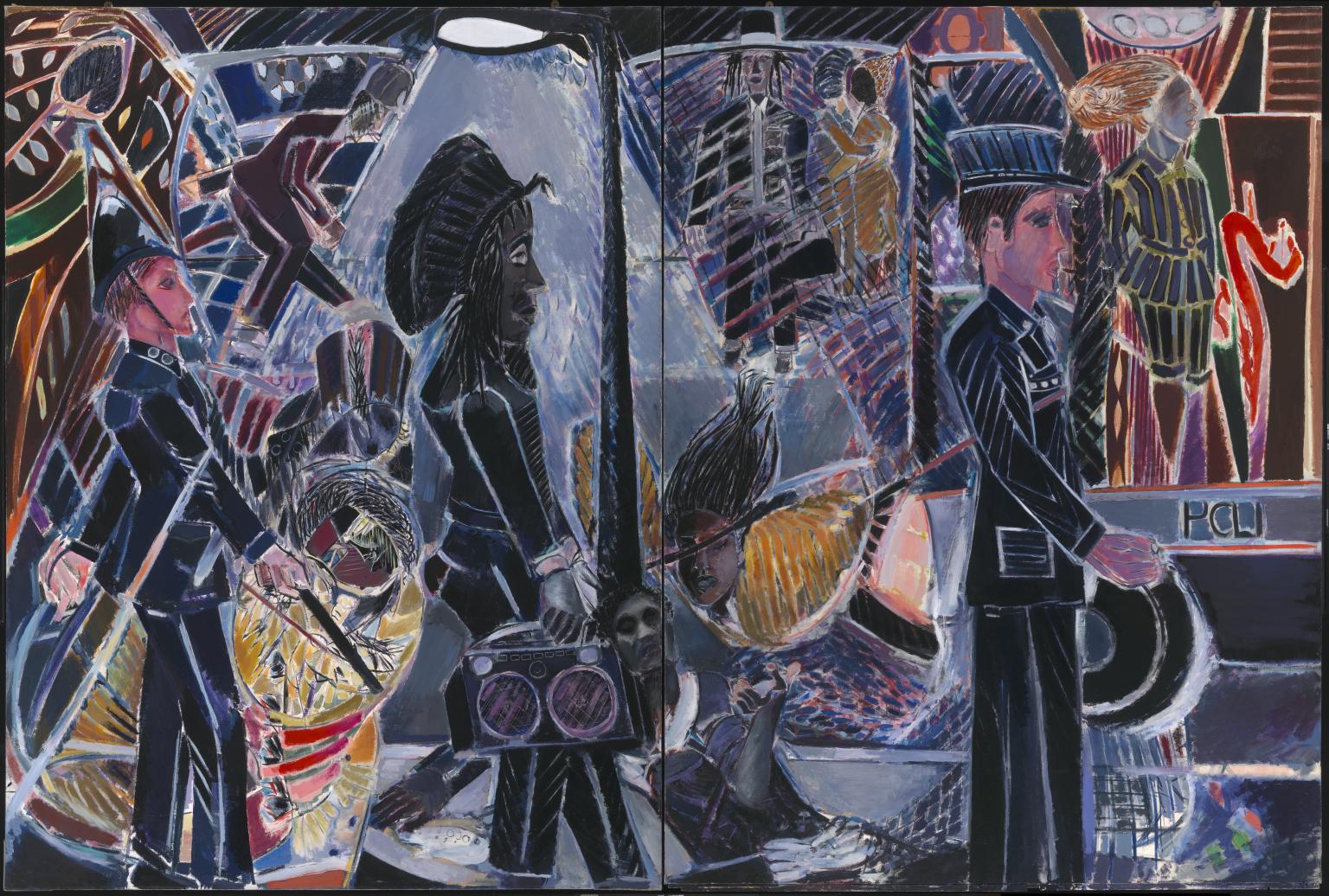
Denzil Forrester MBE, Three Wicked Men 1982
29/30
artworks in Sixty Years: The Unfinished Conversation
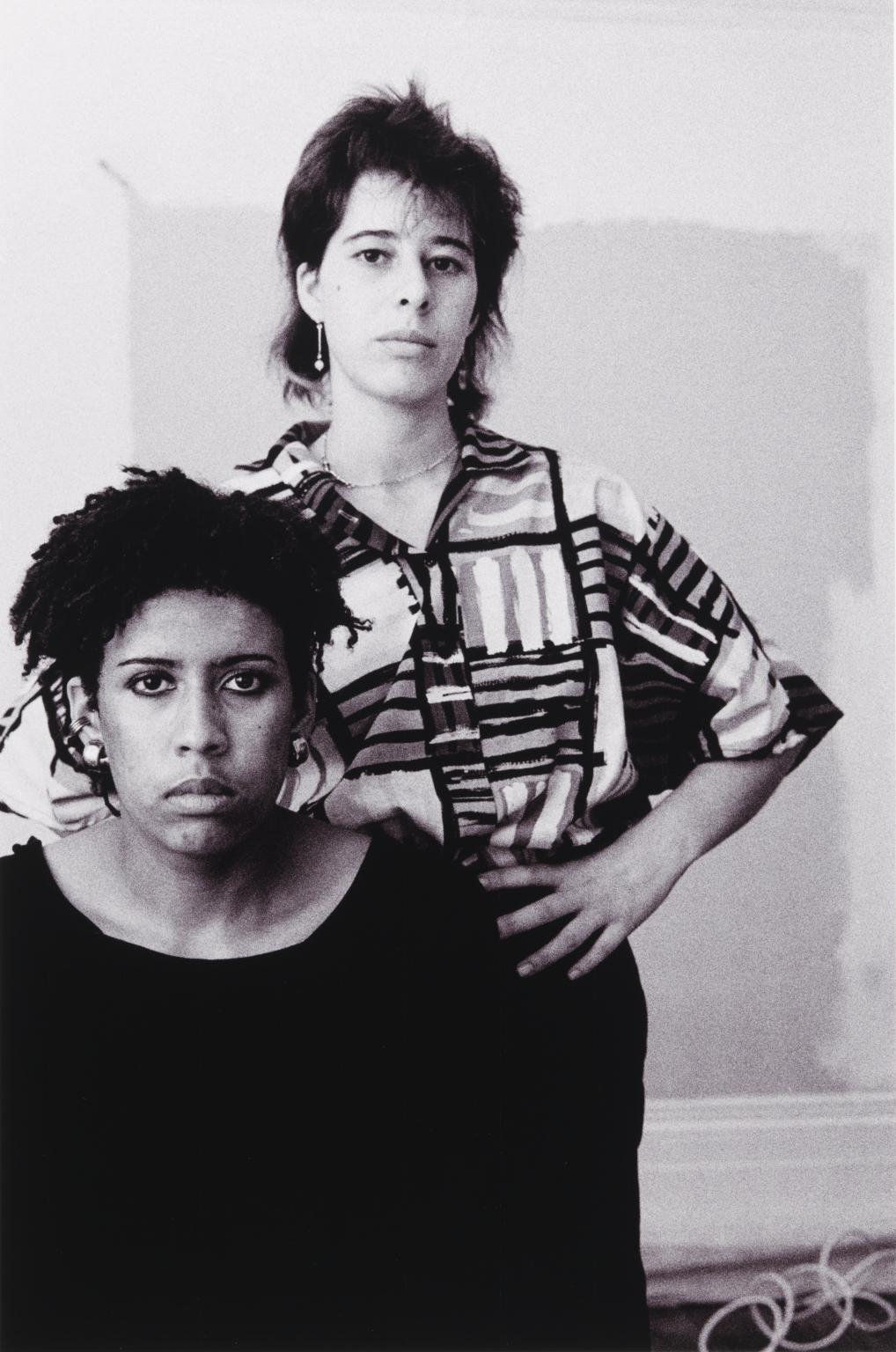
Sunil Gupta, Lisa & Emily, London 1984, printed 2018
This is one of a group of photographs in Tate’s collection from Sunil Gupta’s Lovers: Ten Years On, a series of over thirty black and white portraits of gay couples taken in the United Kingdom between 1984 and 1986 (Tate P82123–P82137 and Ian and Julian P13784). With the exception of Martin & Gary, Newcastle-upon-Tyne 1984 (Tate P82123), they were all taken in London. Lovers: Ten Years On was made after Gupta’s own ten-year relationship ended and, as a form of social analysis, he decided to document the long-term gay relationships he encountered and the changing sensibilities of the social environment he found himself a part of. Most of the subjects are from his own social milieu at the time, professional couples resident in the Greater London area. Taken over a period of two years, the black and white portraits all follow the same format – they are shot in domestic interiors, the poses and arrangements reminiscent of traditional family photographs. The subjects are centred in the frame and look directly into the camera. Most of the couples are shown in affectionate poses and embraces within their domestic settings; some included their pets in the picture, others chose to be depicted in front of works of art in their living rooms, surrounded by books, or in their kitchens.The series was accompanied by an artist’s statement, in which Gupta observed that while there had been a shift in gay self-consciousness since the 1970s, the arrival of HIV and Aids had once again turned public opinion against the acceptance of homosexuality, and that its popular and commercial representations were dominated by a stereotype of deviance. In contrast, the couples in Lovers: Ten Years On are shown as often quite ordinary, white middle-class, professional people in long term monogamous relationships. Gupta wrote:
30/30
artworks in Sixty Years: The Unfinished Conversation
Art in this room

Sorry, no image available




























You've viewed 6/30 artworks
You've viewed 30/30 artworks
